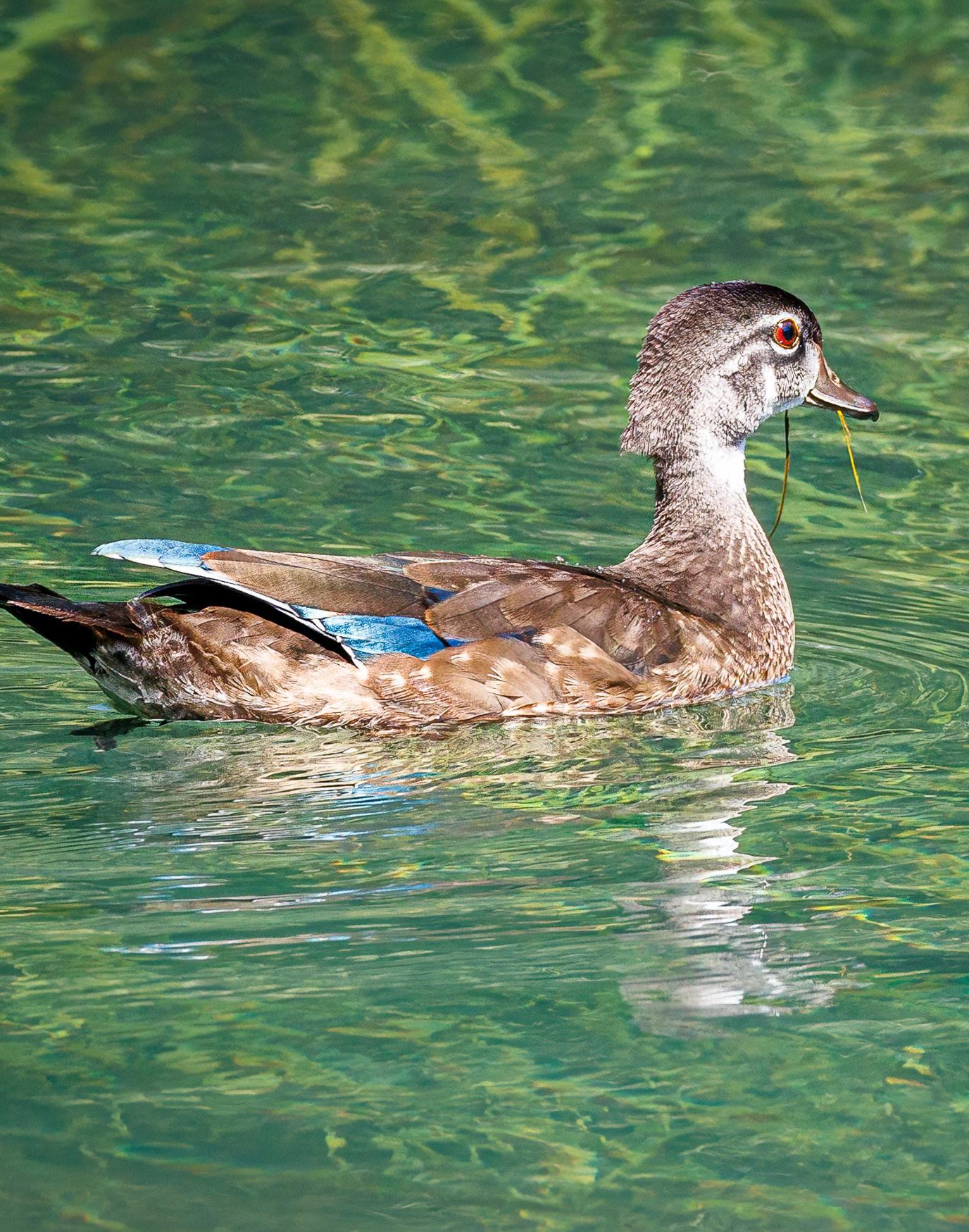

CONSERVATION FEDERATION
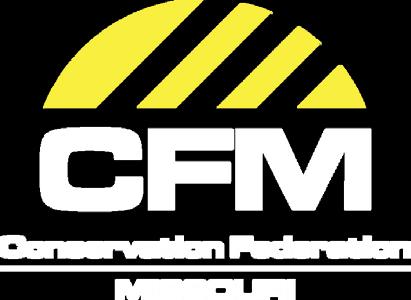

For more than eighty-nine years, the Conservation Federation of Missouri (CFM) has served as “The Voice for Missouri Outdoors.” Join in our efforts to secure our stronghold as advocates for our state’s wildlife and natural resources by becoming a dedicated member of our Founders Circle.
Your contribution will play an influential role in preserving Missouri’s rich outdoor legacy.
Each year, earnings from the endowment will be used to support CFM’s education and advocacy efforts. Special recognition will be given to those who reach each level of giving. Additionally, memberships will be recognized at our annual Convention.
Make your contribution today, to preserving our state’s conservation legacy.
A Legislative Session of Conservation Challenges and Victories
As the 2025 Missouri legislative session comes to a close, I’m proud to report that the Conservation Federation of Missouri (CFM) achieved a major victory for our natural resources with the passage of Senate Bill 105 – the Invasive Species Bill. This important piece of legislation strengthens Missouri’s ability to address the spread of destructive invasive species that threaten our native wildlife, forests, waters, and agricultural lands. It’s a win for conservation—and a direct result of the hard work and commitment of our members and partners.
None of this would have been possible without the support and engagement of our dedicated conservation community. Thank you to everyone who reached out to your elected officials, made calls, sent emails, and used our Legislative Action Center to make your voices heard. Your advocacy truly made the difference.
A special thanks goes to Kyna Iman, our tireless lobbyist, who works day in and day out in the Capitol building, forging relationships and ensuring conservation remains a priority. I also want to recognize Zach Morris, chair of our Legislative Committee, for his strategic leadership and policy insight, and Steve Jones, who ensures our Legislative Action Center stays current and accessible to all of you. Together, this team makes CFM’s legislative presence strong and effective.
Beyond Missouri, we’re seeing growing national challenges to conservation policy—whether it’s the rollback of environmental protections, public land access issues, or threats to funding for fish and wildlife programs. As these issues emerge, CFM is increasingly being called upon to provide input at the national level. Our ability to respond and represent Missouri’s conservation values on a broader stage is expanding, and your continued support helps ensure we can meet those challenges head-on.

At our most recent annual convention, CFM members passed a number of important resolutions that will guide our advocacy in the year ahead. These resolutions are more than symbolic—they are a declaration of our collective priorities and values, and they provide the foundation for the actions we take in Jefferson City and beyond. Whether it’s supporting clean water, protecting wildlife habitat, or ensuring sound science guides natural resource policy, your voice through CFM has never been more important.
Thank you for being part of this work. When we speak together—as members, advocates, and stewards of Missouri’s outdoors—we amplify the voice of conservation across the state and beyond. Let’s continue to build on this momentum in the seasons ahead.
Yours in Conservation,
Tyler Schwartze CFM Executive Director, Editor
Executive Director Tyler Schwartze takes a photo with Rep. Bruce Sassmann and CFM Lobbyist Kyna Iman moments after SB 105, the Invasive Species Bill, passed the House. (Photo: CFM)
CONTENTS Features
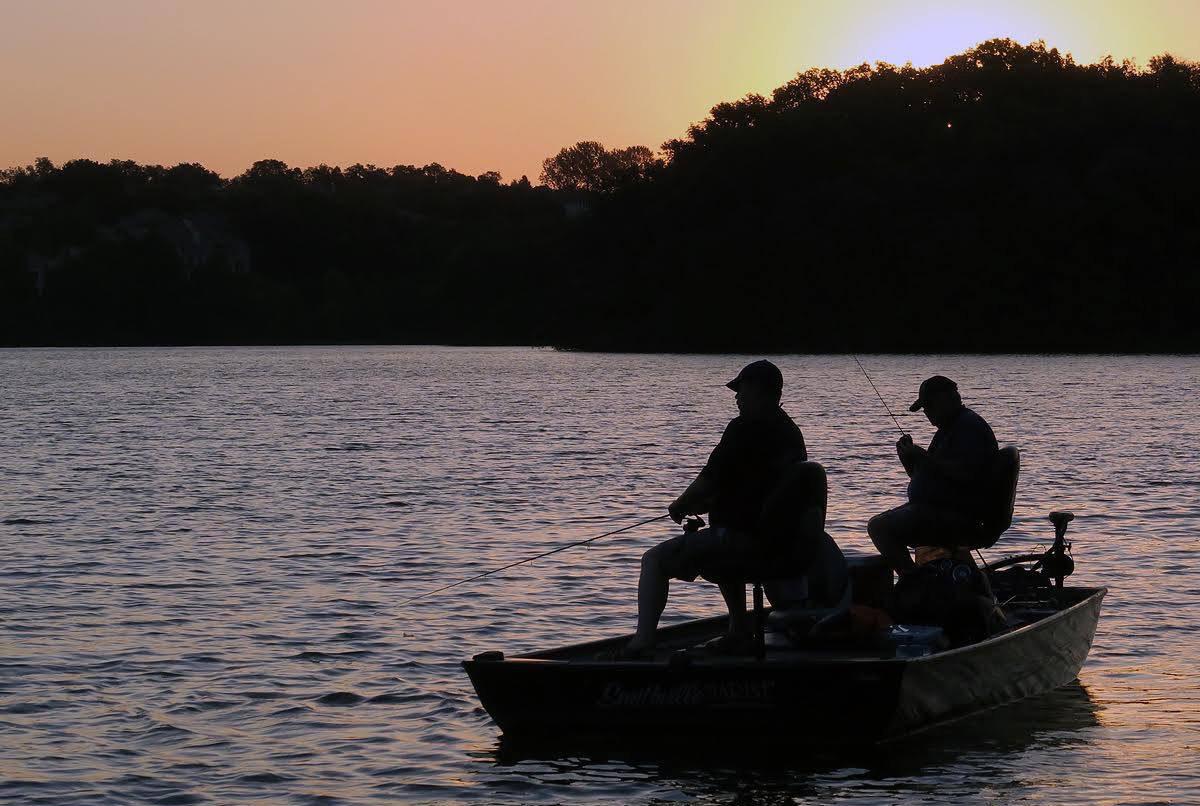

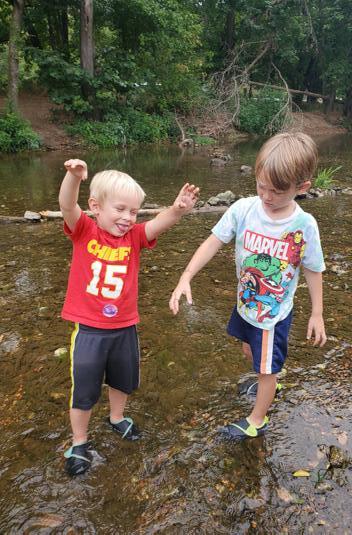
Science Saved Missouri's Paddlefish
Prescribed Burn Associations Provide Valuable Assistance to Landowners
Golden Prairie: Recognizing 50 Years as a National Natural Landmark
Schwartz, Leopold, and the Almanac
Our Great Outdoors
The Sentinel
The Adventures of Frank & Ed: Camping at Roaring River
Summertime Tactics for Missouri Crappie
Back to Seed: Where the Story Begins
Turning off the Plastic Tap: How Local Advocacy Can Drive Big Change
Panfish are King
Fostering Bird-Friendly Communities
STAFF
Tyler Schwartze - Executive Director, Editor
Micaela Haymaker - Director of Operations
Michelle Gabelsberger - Membership Manager
Trisha Ely - Development & Events Coordinator
Joan VanderFeltz - Administrative Assistant
Emma Kessinger - Creative Director
BOARD OF DIRECTORS
Executive Committee:
Bill Kirgan, President
Ginny Wallace, President-Elect
Steve Jones, Vice President
Benjamin Runge, Secretary
Ryan Verkamp, Treasurer
Board Members:
Richard Ash
Mossie Schallon
Gary Van De Velde
Dick Wood
Jake Swafford
Emily Tracy-Smith
Jim Low
Ralph Duren
Katherine Brookshire
Leanne Tippett-Mosby
Adam Sapp
Emily Schrader
Jennifer Battson-Warren
Bill Cooper
Governor Jay Nixon
Wes Swee
Dana Ripper
Zach Morris
Lisa Allen
Tom Westhoff
Mike Schallon
Katie Marsh
Kyle Carroll
Jean Nock
David Urich
Jeff Meshach
Kathie Brennan
Laurie Wilson
William Hall
Michael Meredith
Alexander Scott
Ryan Coovert
April Hoffman
Eric Rahm
Dave Murphy
Kaley Brittain
John Hickey
Cydney Mayfield
Dr. Jane Williams
Kendra Varns Wallis
Pam Bollinger
ABOUT THE MAGAZINE
Conservation Federation (ISSN 1082-8591), Copyright 1938, is published 6 times a year in January, March, May, July, September, and November by the Conservation Federation of Missouri (CFM), 728 West Main, Jefferson City, MO 65101. Of each member’s dues, $10 shall be for a year’s subscription to Conservation Federation. Call (573) 634-2322 to become a member. Periodicals Postage paid at Jefferson City, MO.
Send address changes to:
Conservation Federation 728 West Main Jefferson City, MO 65101
FRONT COVER
The female wood duck was photographed by Dan Bernskoetter at Ha Ha Tonka State Park with a Canon R5 camera and a Sigma 500mm F4 lens and 1.4 teleconverter at 1/640 sec., f/9.0 aperture and ISO 1250.
Thank you to all of our Business Partners.
Platinum



Gold
Doolittle Trailer
Enbridge, Inc.
G3 Boats
Silver
Forrest Keeling Nursery
Lilley’s Landing Resort & Marina
Missouri Wildflowers Nursery
Bronze
Association of Missouri Electric Coop.
Black Widow Custom Bows, Inc.
Brockmeier Financial Services
Burgers’ Smokehouse
Central Electric Power Cooperative
Iron
AJ's Automotive & Air Conditioning
Bass Pro Shops (Independence)
Bee Rock Outdoor Adventures
Big Bear Butcher Shop
Boone Electric Cooperative
Cap America
Central Bank
Custom Promotional Branding
Dickerson Park Zoo
Pure Air Natives
Redneck Blinds
Rusty Drewing Chevrolet
Roeslein Alternative Energy, LLC
Mitico Quaker Windows
Starline, Inc.
St. James Winery
Drury Hotels
HMI Fireplace Shop
Hodgdon Powder Company, Inc.
Missouri Wine & Grape Board
NE Electric Power Cooperative, Inc.
NW Electric Power Cooperative, Inc.
Ozark Bait and Tackle
Woods Smoked Meats
Farmer’s Co-op Elevator Association
FCS Financial
Gascosage Electric Cooperative
General Printing Service
GREDELL Engineering Resources, Inc.
Heartland Seed of Missouri LLC
Hulett Heating & Air Conditioning
Joe Machens Ford
Lewis County Rural Electric Coop.
Marble Graphics II LLC
Midwest Mailing Services
ModernLitho Jefferson City
Moneta Group
On Time Toner and Supplies LLC
Peapod Learning Center LLC
Remembrance Forest
Truman’s Bar & Grill
United Electric Cooperative, Inc.
Your business can benefit by supporting conservation. For all sponsorship opportunities, call (573) 634-2322.






FUNDRAISER RAISER

No Cash is needed to begin a fundraiser. Payment is due at the time your order is placed. Free shipping & Handling on All orders over 50 items. Free sales brochures and order forms. Brochures and order forms are available to download.








President's Message
The Joy of Giving
There is tremendous satisfaction in contributing to people and organizations that we choose to support, whether it be emotional, material or financial. The act of giving and being able to give is one of life’s great joys, in my opinion.
The generosity of our business partners to CFM cannot be overstated. I dare not begin to name them and their contributions for fear of leaving someone out, but needless to say, they are most generous in sponsoring events, donating to our raffles and auctions and contributing to specific programs such as Share the Harvest and the Conservation Leadership Corps. We are truly thankful for them and all their contributions to our organization.
Along with our business partners, we have received some incredibly generous donations from individuals in recent months and years that fund programs that are important to them. With the risk of leaving someone out, I would like to note a few:
The David Risberg Memorial Affiliate Grants were established by John and Mary Risberg in honor and memory of their son David, who died in an accident and loved the outdoors. This memorial helps fund the various projects of CFM’s affiliate organizations as they work to improve Missouri’s outdoors. The annual funding of those projects runs about $ 30,000 per year. John and Mary have been supportive in so many ways and love to see the boots-on-the-ground projects that get completed each year in David’s honor.
Dan and Connie Burkhardt have long been supporters of the Missouri outdoors with a particular fondness for the Katy Trail. To that end, they have pledged funding to upgrade the Katy Trail Turner Shelter in Tebbetts, and creation of an overnight facility in Treloar. In addition, they have also committed to a sizable contribution to purchase a much needed new office facility for a future CFM headquarters. Dan and Connie are true conservationists and we are so grateful for their continued support of our mission.

CFM President Bill Kirgan, (far left), and John Risberg (far right) pose with members from the Lake of the Ozarks Watershed Alliance, as they are awarded a grant from the David A. Risberg Memorial Grants at the 2025 CFM Annual Convention. (Photo: CFM)
Bill McCully is establishing the Bill McCully Foundation and is having fun looking at a variety of ways to help fund existing programs, along with creating new ones with a major contribution. We look forward to working with Bill to find ways to support unique ways to contribute to the cause.
Chip and Teresa McGeehan have pledged to be our first Diamond Level Founders Circle members. This was announced at the Springfield event in April, where they were the keynote speakers for the event. See more about Chip and Teresa and their unending willingness to support conservation on page 9.
Speaking of the Founders Circle, please take a look at the inside cover, noting those contributing to the various levels of the Founders Circle who, along with our Life Members, are creating endowments for the activities of CFM far into the future.
Finally, everyone who donates to one of our auctions, buys a raffle ticket, comes to one of our events, makes a memorial donation honoring a friend or loved one or just pays their annual dues - your contribution to Missouri’s outdoors is greatly appreciated.
Bill Kirgan CFM President
CFM Hosts Inspiring Springfield Banquet at Relics Event Center
On the evening of April 10, the Conservation Federation of Missouri (CFM) hosted a Springfield Banquet at the Relics Event Center, bringing together passionate conservationists, generous supporters, and community leaders for an unforgettable night celebrating Missouri’s great outdoors and those working to protect it.
Guests were welcomed into the venue filled with fellowship, laughter, and a shared love for Missouri’s natural legacy. The evening featured a delicious home-cooked dinner of smoked pulled pork, generously provided by CFM President Bill Kirgan and his wife, Mary Ellen. Their hospitality set the tone for a heartfelt evening that left a lasting impact on all who attended.
The highlight of the night came when Chip and Teresa McGeehan took the stage as featured speakers. Their message centered on a deep appreciation for Missouri’s conservation legacy and the critical role that everyday citizens play in preserving it. Teresa shared how she “married into” a love for conservation—but quickly found her own passion for the outdoors and for the mission of CFM.
Chip’s remarks offered a compelling perspective. He spoke openly about his early dreams of pursuing a career in conservation, and how life took him in a different direction— into the corporate world. But instead of stepping away from conservation, Chip found a new way to contribute. He emphasized the importance of supporting conservation work financially, organizationally, and through leadership.
“My career path may have changed, but my commitment to conservation never did,” he said. “Because of where I ended up, I can support Missouri conservation in a completely different and meaningful way.”
Chip also took time to recognize special guests in the room, including a young man who had just competed in the NASP (National Archery in the Schools Program) tournament in Branson—invited by Representative Bruce Sassman. Chip expressed how vital it is to engage young people in conservation, encouraging everyone in the audience to support programs that nurture the next generation of outdoor stewards.
He gave a special shoutout to CFM’s Conservation Leadership Corps (CLC) program, which continues to shape the future of Missouri conservation through youth mentorship and handson learning.

Before concluding his remarks, Chip issued a heartfelt challenge to everyone in attendance to give more. Give often. Support the mission of the Conservation Federation of Missouri—not just at the banquets and fundraisers, but every chance you get.
The evening also included both silent and live auctions, which brought energy and generosity to the room as attendees placed bids on unique items and experiences—all in support of Missouri’s wild places and wildlife. The funds raised will help sustain CFM’s mission and expand its reach across the state.
This event would not have been possible without the incredible hard work and dedication of our Springfield Banquet Committee. We extend our deepest thanks to:
Richard & Judy Ash, Co-Chairs
Denny Bopp
Bill & Misty Bryan
Charles Burwick
Dr. Robert Kipfer
Larry & Brenda Martien
Terry Whaley
Charlie Wormek
Kerry & Charlotte Wynn
Your commitment, planning, and passion for conservation helped make this banquet a resounding success. Thank you for being such an important part of the CFM family!
The Springfield Banquet was more than just a fundraiser—it was a celebration of shared values, meaningful connections, and the belief that everyone has a role to play in conservation. Whether through time, talent, or treasure, the evening proved that the spirit of conservation is alive and thriving in Missouri.
Trisha Ely CFM Development and Events Coordinator
CFM MISSION:
To ensure conservation of Missouri's wildlife and natural resources, and preservation of our state's rich outdoor legacy through advocacy, education and partnerships.
Why I Became a Life Member: Carl Turlin
Iremember when I made up stories that I told my niece about the “white squirrel” searching the leaves for seeds or bugs, leaping away from a hawk or a fox, scanning the forest floor in the morning. She had to be watchful for black snakes, even in the trees. Always alert, always aware. Listening, not just hearing, the sounds of the forest, both day and night. To do otherwise might mean a quick death from below or above.
The squirrel made a story wherever she traveled - her tracks, her actions, her noises, her nests. In reality, each animal, small and large, makes a story that we might discover, but only if we know how to do so, using our own senses. The more ways that our senses can be used, the more stories we can uncover, whether it’s in the soil, in the trees, or in the water. It takes time.
CFM fights to make it possible for these stories to be discovered. That’s what led me to become a life member. I’ve only been a member for a few years, but it dawned on me recently that these folks not only talk about protecting our outdoor rights and opportunities, they actually DO things about it with their time, their money, and their actions. They’re a blend of talents, ages, and perspectives, actively talking through best practices for getting projects done and holding elected officials’ feet to the campfire.
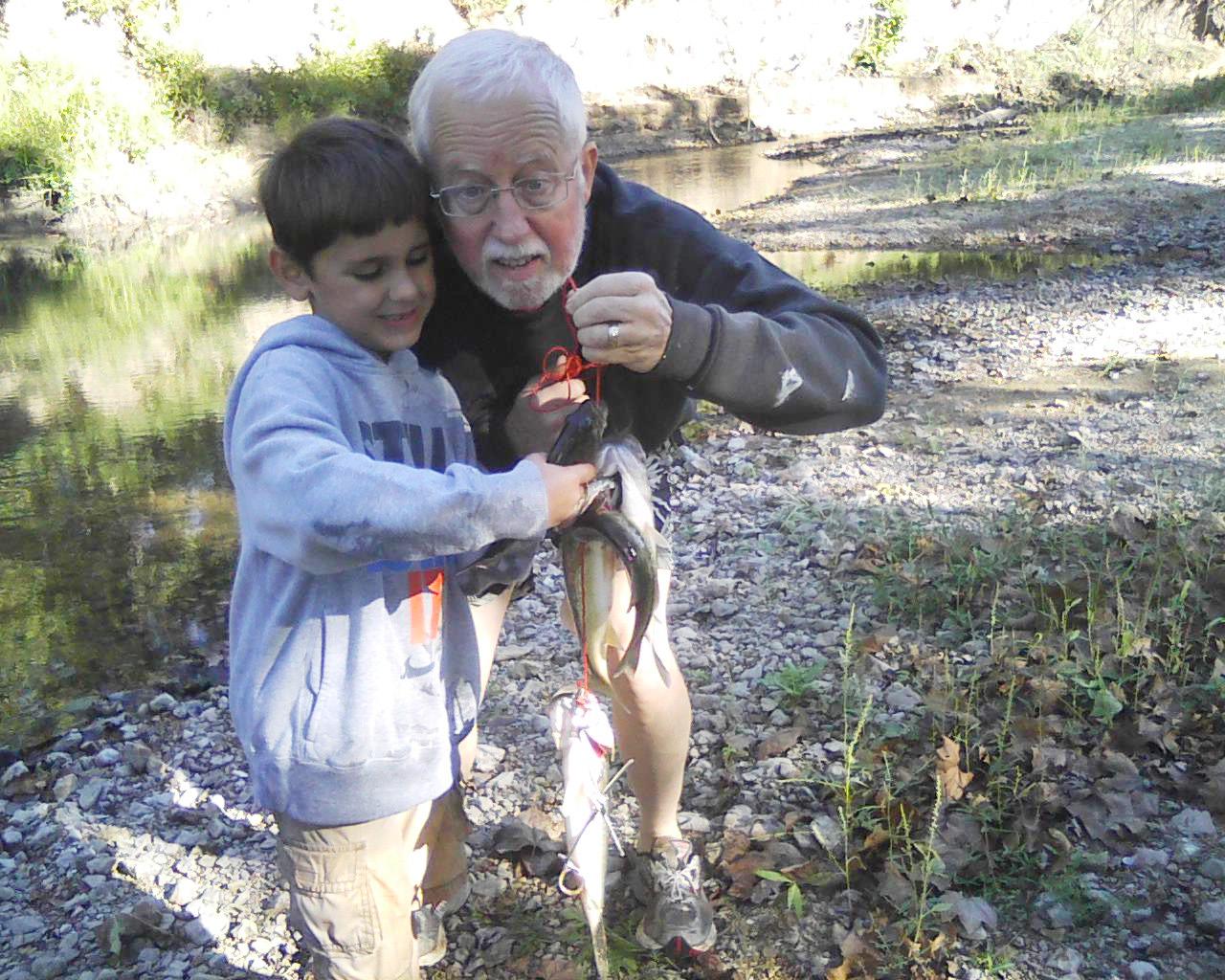
We’ve got to fight other interests NOW, in order to have the places and opportunities in Missouri, and beyond, for our kids and grandkids to explore, to fish, and hunt after our fight is over and they pick it up. That’s why I became a life member.

In Memory & Honor
Allison Roba Vandivort Scotti Iman
G3 Boats
G3 Boats, located in Lebanon, Missouri, began as Generation III in 1992. Yamaha purchased Generation III in March of 1997 and shortly thereafter the facility was expanded to produce a full line of quality aluminum fishing and pontoon boats under the brand G3 Boats. Our partnership with CFM ensures that future generations will continue to have great outdoor adventures in Missouri.

Becoming the name that anglers, duck hunters, recreational boated, and more have known and trusted for over 25 years didn't happen by coincidence. G3 Boats, originally founded in 1992 by a third-generation boat builder as "Generation III Boats," was a rising star in the aluminum boat building capital of the world, Lebanon, Missouri, when they caught the eye of Yamaha Motor Corporation.
At G3 Boats, we strive to provide three key features for every G3 boat owner: Quality, Performance and Satisfaction. Through a total team approach, our family of highly trained craftsmen, many of whom have been in the industry for decades, consistently produce boats with quality fit and finish, outstanding on-water performance, and ultimately, exceptional customer satisfaction. That's because our team members, from the manufacturing floor to the management staff, are family boaters and fisherman, just like our customers.
Quaker Windows & Doors
Quaker Windows & Doors is manufacturer of residential and commercial window and door products. As a company that has been Missouribased since we began in 1949, we have always been proud of our state's natural beauty. Thus we are honored to partner with the Conservation Federation of Missouri to preserve those wonders for generations to come.
Headquartered in Freeburg, MO, Quaker is among the top window and door producers in the country. Along with our Freeburg location, Quaker also has campuses in Vienna, MO and Eldon, MO. Between the 3 locations, we have more than 33 acres under roof with another 10 acres of space being added in 2025-2026. Quaker is still family-owned, led by 2nd and 3rd generation ownership whose commitment to the company and their workforce stands strong.
As an outboard motor brand with its own unmatched reputation for quality, performance and reliability, Yamaha recognized that this likeminded boat builder as the potential to bring a quality boating experience to a much larger audience. So, in 1997, we became "G3", a proud Yamaha Boat Company.
G3 Boats manufacturers 130 models of aluminum fishing boats and pontoons at their location in Lebanon, MO.
For more information on the entire line of G3 products visit g3boats.com and suncatcherpontoons.com.
Quaker employs approximately 1,600 people, and manufactures more than 3,000 windows and doors a day. Our product offering is considered the most extensive in our industry, with windows and doors specifically designed and built for residential and luxury homes, as well as commercial structures.

We are also one of the few manufacturers that make aluminum, vinyl and wood windows and doors. Because of this vast product line, and our ability to evolve with an ever-changing building industry, Quaker's focus can always be providing the right solution for our clients. For more information on Quaker Windows & Doors, visit quakerwindows.com
Member News
LIFE MEMBERS OF CFM
Charles Abele
* R. Philip Acuff
* Duane Addleman
* Nancy Addleman
Tom Addleman
Nancy Addleman
* Michael Duane Addleman
James Agnew
Carol Albenesius
Craig Alderman
* Allan Appell
Victor Arnold
Bernie Arnold
Richard Ash
Judy Kay Ash
Carolyn Auckley
Debbie Audiffred
Doug Audiffred
Ken Babcock
Bernie Bahr
Michael Baker
* James Baker
Dane Balsman
Timothy Barksdale
Lynn Barnickol
Jamie Barton
Michael Bass
Robert Bass
Don Bedell
Troy Beilsmith
Thomas Bell
David F. Bender
Rodger Benson
Leonard Berkel
Barbi Berrong
Jim Blair
John Blankenbeker
Amy Bloomfield
Tom Bloomfield
Andy Blunt
Jeff Blystone
Kim Blystone
Glenn Boettcher
Arthur Booth
* Dale Linda Bourg
Stephen Bradford
Marilynn Bradford
Robin Brandenburg
Mark Brandly
Kathie Brennan
Robert Brinkmann
Lon Brockmeier
Katherine Brookshire
Donald R. Brown
* Scott Brundage
Bill Bryan
Misty Bryan
Alan Buchanan
Connie Burkhardt
Dan Burkhardt
Charles Burwick
Brandon Butler
Randy Campbell
Brian Canaday
Dale Carpentier
Joe Cater
* Glenn Chambers
Bryan Chilcutt
Ed Clausen
* Edward Clayton
* Ron Coleman
Denny Coleman
Rhonda Coleman
Liz Cook
Bill Cooper
Elizabeth Copeland
Mark Corio
* Bill Crawford
Andy Dalton
DeeCee Darrow
Mike Dempsey
Ryan Diener
Joe Dillard
Randy Doman
Tim Donnelly
Cheryl Donnelly
Ron Douglas
Chuck Drury
* Charlie Drury
Tom Drury
Ethan Duke
Mike Dunning
William Eddleman
Karen Edison
John Enderle
Theresa Enderle
Joe Engeln
Marlin Fiola
* Mary Louise Fisher
Howard Fisher
Andrew Fleming
Brian Fleming
* Charles Fleming
David Fleming
Howard Fleming
Kailey Fleming
Lori Fleming
Matt Fleming
Paula Fleming
Sara Fleming
Bob Fry
Manley Fuller
David Galat
Gene Gardner
Matt Gaunt
Jason Gibbs
Timothy Gordon
Blake Gornick
David Graber
Tim Grace
Jody Graff
Richard & Sally Graham
* Joseph Gray
Tom Gredell
Tyler Green
Jason Green
Gery Gremmelsbacher
Debbie Gremmelsbacher
Jason Gremmelsbacher
Bernie Grice Jr.
Mark & Kathy Haas
Tom & Margaret Hall
Christopher Hamon
* Deanna Hamon
J. Jeff Hancock
Herman Hanley
Keith Hannaman
Elizabeth Hannaman
Lonnie Hansen
Bryan Hargiss
John Harmon
* Milt Harper
Jack Harris
David Haubein
Jessica Hayes
* Susan Hazelwood
Mickey Heitmeyer
Loring Helfrich
* LeRoy Heman
* Randy Herzog
Todd Higgins
Bill Hilgeman
Jim Hill
John Hock
April Hoffman
Mike Holley
Rick Holton
CW Hook
* Allan Hoover
Amanda Horne
John Hoskins
Todd Houf
* Mike Huffman
Wilson Hughes
Larry Hummel
* Patricia Hurster
Kyna Iman
Jason Isabelle
Jim Jacobi
Aaron Jeffries
Robert Jernigan
Jerry Jerome
Roger & Debbie Johnson
* Don Johnson
* Malcolm Johnson
* Pat Jones
Steve Jones
John Karel
Thomas Karl
Jim Keeven
* Duane Kelly
Cosette Kelly
Junior Kerns
Todd Keske
Robert Kilo
* Martin King
Bill Kirgan
* Judd Kirkham
* Ed Kissinger
Sarah Knight
TJ Kohler
Jeff Kolb
Chris Kossmeyer
Chris Koster
Dan Kreher
Carl Kurz
* Ann Kutscher
Larry Lackamp
Kyle Lairmore
* Jay Law
Michael Leach
* Gerald Lee
Debra Lee
Mark Lee
Randy Leible
Wade Leible
* Joel LeMaster
* Norman Leppo
* John Lewis
Phil Lilley
Bill Lockwood
Leroy Logan
Christine Logan - Hollis
Bob Lorance
Ike Lovan
Wayne Lovelace
Kimberley LovelaceHainsfurther
Jim Low
Mark Loyd
Mary Lyon
Emily Lute-Wilbers
Martin MacDonald
Michael Mansell
Steve Maritz
Danny Marshall
Brenda Martien
Larry Martien
Edward Martin
John Mauzey
Cydney Mayfield
Bill McCully
Chip McGeehan
Teresa McGeehan
Justin McGuire
Nathan "Shags" McLeod
Jon McRoberts
Richard Mendenhall
Tom Mendenhall
Donna Menown
John "Mitch" Mertens
Cynthia Metcalfe
Walter Metcalfe
Larry Meyer
Stephanie Michels
Brooks Miller
Mitchell Mills
Joshua Millspaugh
Davis Minton
Bill Moeller
Lowell Mohler
John Moore, Jr.
Gary Moreau
Johnny Morris
Mary Morris
Zachary Morris
Butch Morrissey
Keri Morrissey
John Mort
David Mosby
Leanne Mosby
Steve Mowry
Diana Mulick
David Murphy
* Dean Murphy
Richard Mygatt
* Steve Nagle
Rehan Nana
Robert Naumann
Phil Needham
J. Roger Nelson
Jeremiah (Jay) Nixon
Gary Novinger
Frank & Judy Oberle
Larry O'Reilly
Charlie & Mary O’Reilly
Beth O'Reilly
Anya O'Reilly
Jeff Owens
Austin Owens
Jeffrey Panchot
Sara Parker Pauley
Scott Pauley
Randy Persons
Edward Petersheim
Albert Phillips
Jan Phillips
Glenn & Ilayana Pickett
Jessica Plaggenberg
Becky Plattner
Zach Pollock
Jerry Presley
Albert Price
Nick Prough
Kirk Rahm
Kurtis Reeg
John Rehagen
David & Janice Reynolds
Carey Riley
Kevin Riley
Mike Riley
Dana Ripper
John Risberg
Mary Risberg
Ann Ritter
Charles Rock
Derrick Roeslein
Rudy Roeslein
Charles Rogers
Kayla Rosen
Gerald Ross
Pete Rucker
Benjamin Runge
Tyler Ruoff
William Ruppert
Tom Russell
Jacob Sampsell
Bruce Sassmann
Jan Sassmann
Frederick Saylor
Michael Schallon
Mossie Schallon
* Evelyn Schallon
Thomas Schlafly
Pamela Schnebelen
Don Schultehenich
Deb Schultehenrich
Tyler Schwartze
* Ronald Schwartzmeyer
Timothy Schwent
Travis W. Scott
George Seek
Arlene Segal
* E. Sy Seidler
* Sara Seidler
Joshua Shadwick
Anita Siegmund
Emily Sinnott
Douglas Smentkowski
Gary & Susanna Smith Zachary Smith
* M.W. Sorenson
* Ed Stegner
Jeff Stegner
Everett Stokes
William Stork Jr.
Robert Stout
Winifred Stribling
Norm Stucky
Mary Stuppy
* Mark Sullivan
Jacob Swafford
Jim Talbert
Norman Tanner
Travis Taylor
Richard Thom
Don Thomas
Tim Thompson
Jim Thornburg
* Jeff Tillman
Robert Tompson
Mike Torres
Matt Tucker
David Urich
Jennifer Urich
Alex Uskokovich
Gary Van De Velde
Barbara vanBenschoten
Lee Vogel
Albert Vogt
Frank Wagner
Ray Wagner
* Julius Wall
Ginny Wallace
Mervin Wallace
Jennifer Battson Warren
Randy Washburn
Mary Waters
* Henry Waters, III.
Daniel Weinrich
Michael Weir
Robert Werges
Evelyn Werges Bennish
Tom Westhoff
Gary Wheeler
Georganne Wheeler Nixon
Rayburn Whitener
Mark Williams
Dennis Williams
Dr. Jane Williams
Stephen Wilson
Michael Wilson
Laurie Wilson
Jonathan Wingo
Jon R. Wingo
Michael Wiseman
Daniel Witter
Brenda Witter
* Addie Witter
Olivia McKinney Witter
Owen Witter
Shirley Wolverson
* Dick Wood
Howard Wood
Joyce Wood
Nicole Wood
Charles M. Wormek
Brad Wright
Evan Wright
Suzanne Wright
David Young
Judy Young
Dan Zekor
Daniel Zerr
Jim Zieger
Robert Ziehmer
Emily Ziehmer
Lauren Ziehmer
Colton Zirkle
Ethan Zuck
Guy Zuck
Mark Zurbrick
*Deceased
Southwest Missouri Fly Fishers
Our enthusiastic group was founded in 1982 by 12 friends dedicated to pursuing and sharing the art of fly fishing. Today, we have over 100 strong members, and we are experiencing steady growth in membership and participation in events and activities.
We have found that the sport and arts of fly fishing draw folks of all ages and from all backgrounds and socioeconomic levels. It is truly a sport where the factors of sharing knowledge and skill development are foundational.

The mission of the group focuses on three core efforts: education, conservation, and community (fellowship). This is the core mission of our international affiliation, Fly Fishers International (FFI), based in Livingston, Montana. Examples of our mission being consistently carried out include: monthly educational programs on fly fishing and conservation, monthly educational sessions on fly tying and fly casting skills, outings to streams and lakes, co-hosting fly tying and fly casting demonstrations at the American Museum of Fly Fishing gallery in the Wonders of Wildlife National Museum and Aquarium.
We conduct semi-annual Volunteer Water Quality Monitoring as Missouri Stream Team #57 at Crane Creek in Stone County, organizing litter pick-ups along the stream and roadways at Crane Creek. We also host free women-only events at Bennett Spring State Park that teach the basic skills of fly fishing (casting, rigging, knot tying, fly tying and catching fish). We host an annual fundraising banquet for members and their guests that funds nearly all our activities, and host the F3T Fly Fishing Film Tour at a local theatre for members and guests to promote interest in our club and fellowship among all attending fly fishers.
Monthly programs are held on the second Thursday of each month, and fly tying and casting sessions are held on the third Thursday of each month. We encourage all members to become members of Fly Fishers International (www.flyfishersinternational.org) and Trout Unlimited (www.tu.org).

Top - Women’s Only Fly Fishing Event at Bennett Spring Bottom - Annual Mountain Springs Outing (Photos: Amanda Miller)
Affiliate Organizations
Anglers of Missouri
Association of Missouri Electric Cooperatives
Basshole Bass Club
Bass Slammer Tackle
Burroughs Audubon Society of Greater Kansas City
Capital City Fly Fishers
Chesterfield Citizens Committee for the Environment
Columbia Audubon Society
Conservation Foundation of Missouri Charitable Trust
Dark Sky Missouri
Deer Creek Sportsman Club
Duckhorn Outdoors Adventures
Festus-Crystal City Conservation Club
Forest and Woodland Association of Missouri
Forest Releaf of Missouri
Friends of Rock Bridge Memorial State Park
Gateway Sustainable Farmers Alliance
Greater Ozarks Audubon Society
Greenbelt Land Trust of Mid-Missouri
Greenway Network, Inc.
James River Basin Partnership
L-A-D Foundation
Lake of the Ozarks Watershed Alliance
Land Learning Foundation
Legends of Conservation
Magnificent Missouri
Mid Mo Prescribed Burn Assn.
Mid-Missouri Outdoor Dream
Mid-Missouri Trout Unlimited
Midwest Diving Council
Mississippi Valley Duck
Hunters Association
Missouri Association of Meat Processors
Missouri B.A.S.S. Nation
Missouri Bear Foundation
Missouri Bird Conservation Initiative
Missouri Birding Society
Missouri Bluebird Society
Missouri Bow Hunters Association
Missouri Caves & Karst Conservancy
Missouri Chapter of the American Fisheries Society
Missouri Chapter of the Wildlife Society
Missouri Coalition for the Environment
Missouri Conservation Corps
Missouri Conservation Heritage Foundation
Missouri Conservation Pioneers
Missouri Consulting Foresters Association
Missouri Disabled Sportsmen
Missouri Ducks Unlimited- State Council
Missouri Environmental Education Association
Missouri Environmental Education Projects
Missouri Forest Products Association
Missouri Grouse Chapter of QUWF
Missouri Hunting Heritage Federation
Missouri Master Naturalist
- Great Rivers Chapter
Missouri Master Naturalist
- Hi Lonesome Chapter
Missouri Master Naturalist
- Osage Trails Chapter
Missouri Master Naturalist
- Springfield Plateau Chapter
Missouri National Wild Turkey Federation
Missouri Native Seed Association
Missouri Outdoor Communicators
Missouri Park & Recreation Association
Missouri Parks Association
Missouri Prairie Foundation
Missouri River Bird Observatory
Missouri River Relief
Missouri Rock Island Trail, Inc.
Missouri Rural Water Association
Missouri Smallmouth Alliance
Missouri Society of American Foresters
Missouri Soil & Water Conservation Society-Show-Me Chapter
Missouri Sport Shooting Association
Missouri State Parks Foundation
Missouri Taxidermist Association
Missouri Trappers Association
Missouri Trout Fishermen's Association
Northside Conservation Federation
Open Space Council of the St. Louis Region
Outdoor Skills of America, Inc.
Ozark Chinquapin Foundation
Ozark Fly Fishers, Inc.
Ozark Land Trust
Ozark Rivers Audubon Chapter
Ozark Riverways Foundation
Ozark Trail Association
Ozark Wilderness Waterways Club
Perry County Sportsman Club
Pomme De Terre Chapter Muskies
Quail & Upland Wildlife Federation, Inc.
Quail Forever & Pheasants Forever
Renew Missouri
River Access Coalition
River Bluffs Audubon Society
Scenic Missouri, Inc
Scenic Rivers Invasive Species Partnership (SRISP)
South Side Division CFM
Southwest Missouri Fly Fishers
St. Louis Audubon Society
Stream Teams United Student Air Rifle Program
The Conservation Fund
Tipton Farmers & Sportsman's Club
Tri-Lakes Fly Fishers
Turtle Conservation Group
United Bowhunters of Missouri
Wild Bird Rehabilitation
Wild Souls Wildlife Rescue Rehabilitation
WildHERness
Wonders of Wildlife
World Bird Sanctuary
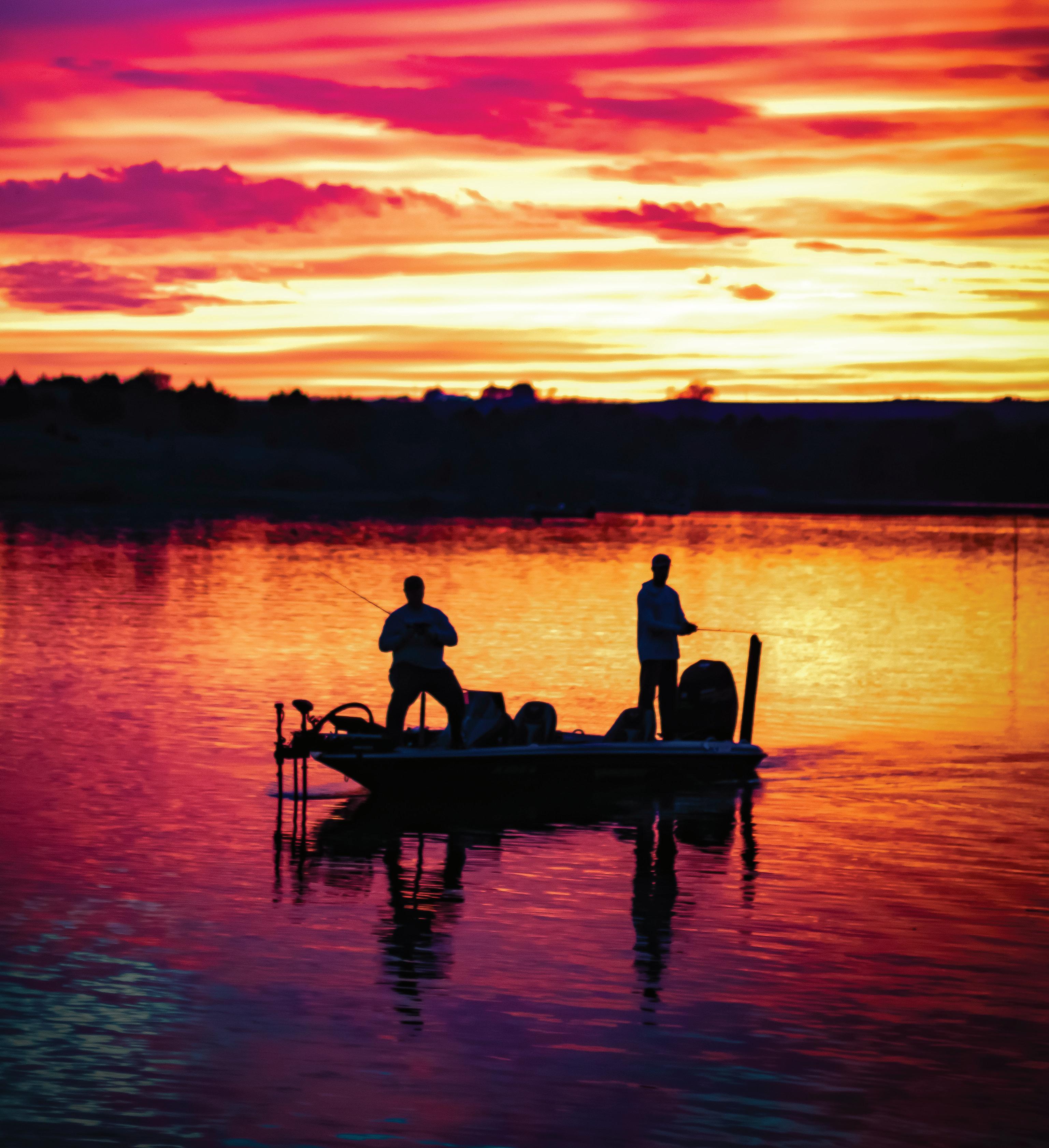

Experiencing Conservation Leadership Corps
When I first joined Conservation Leadership Corps (CLC) in 2020, I wasn't sure what path I wanted to take, but the experiences I was able to be a part of and the people I have been able to meet as a part of CLC led me to realize my passion for conservation.
This experience led me to major in wildlife conservation and management at Missouri State University. After a year in the program, I started leading the resolutions. My first resolution I led was over rainwater collection, it did not get passed, but while researching as a part of the resolution process, I learned about many more topics I otherwise would not have. And hearing the issues my fellow CLC students research teaches me something new every year.
I think one of the most significant aspects of CLC is how much collaboration takes place between students and professionals and how much knowledge is shared and gained throughout the resolution process and committee meetings.
Being a part of these conversations gave me the practice to be confident enough to approach professionals outside of CLC to inquire about their careers and learn more from people everywhere I go. CLC has equipped me to be the young professional I am today, and I would recommend it to any college student with a passion for conservation.



Top - Photos: Kaley Brittain, CLC President Bottom - CLC at the 2025 Annual Convention (Photo: CFM)
Kaley Brittain
Feature Story Looking Back Missouri’s Conservation History
Science Saved Missouri’s Paddlefish
Ecological disasters happen. Sometimes we see them coming; sometimes we don’t. But thankfully we saw this one coming and decided to do something about it.
Missouri’s paddlefish fishery was on the brink of a major disaster in the 1960’s. The U.S. Army Corps of Engineers was breaking ground for Truman Dam and Reservoir on the Osage River which would permanently flood all known spawning areas for paddlefish. Without places to spawn, there would be no recruitment, resulting in declining numbers of fish and loss of an important fishery. It was up to the Missouri Department of Conservation (MDC) to do something but what? The obvious solution was to produce paddlefish in a hatchery and stock them. But, paddlefish had never been cultured before. We would have to obtain eggs, hatch them and raise the young to a stocking size. Since paddlefish are filter feeders, it was not known whether young fish could be raised in hatchery ponds, in large enough numbers to stock or what size the fingerlings would need to be to survive? And, how would we know if the stocked fish survived? So many important questions and not enough answers. Using what we did know, we set out to find answers to ensure that the paddlefish population and fishery in the Osage River Basin would remain viable after Truman Dam and Reservoir was completed.
Former MDC Assistant Director Charles Purkett had unraveled the mysteries of where and when paddlefish reproduced in the wild. Paddlefish only spawn in running water and require a precise timing of events to get them in the mood. We believed hormones would induce females to release their eggs and started to work on it in 1964. I collected wild fish each spring and injected them with various hormones and dosages with much frustration and few eggs to show for my efforts. Finally, I hit on a combination that produced fair success, but the next challenge was hatching the eggs.
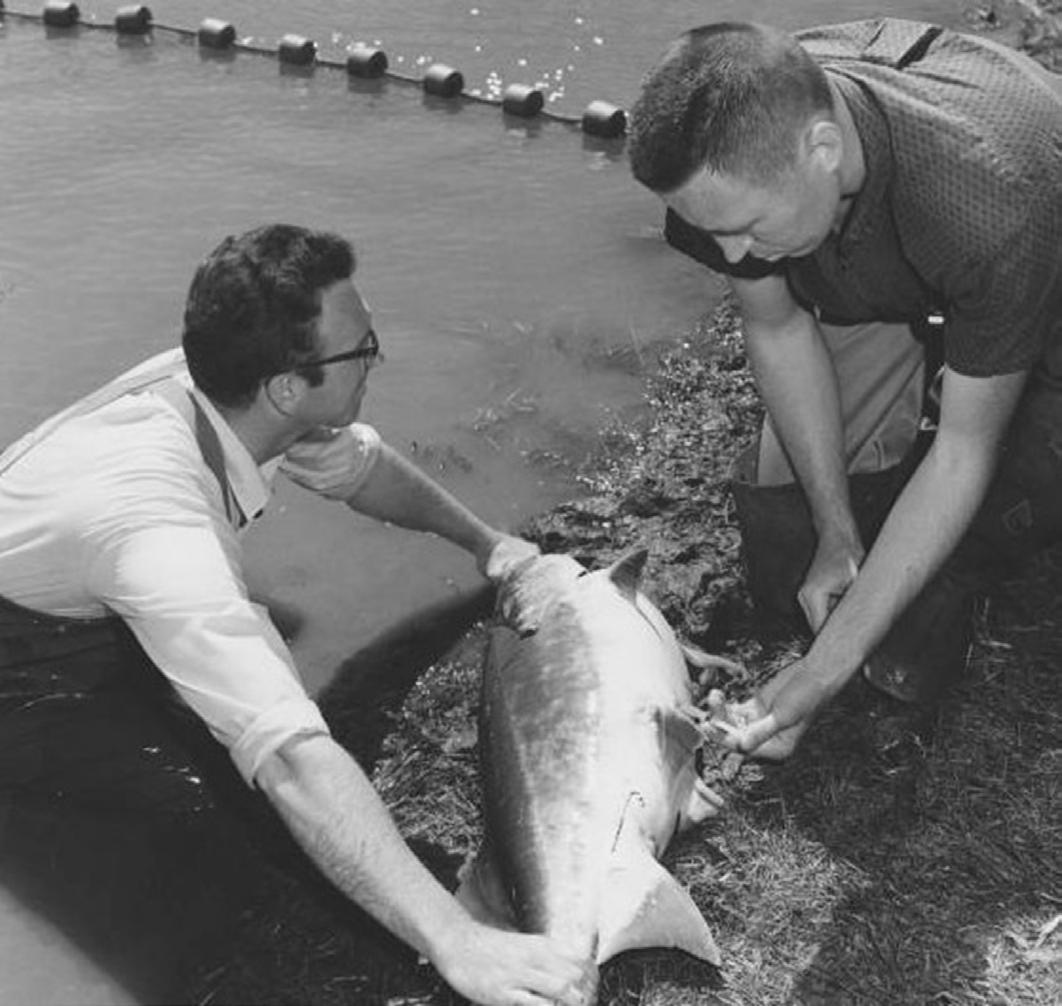
In the wild, paddlefish spawn over gravel which the eggs stick to until they hatch. In the hatchery, the eggs clumped together, and fungus killed them. We used a fine, clay slurry to keep the eggs from clumping but we still didn’t know how to hatch them. My first efforts would have made Rube Goldberg proud. I improvised using a trout incubator in a horse tank. Eggs were placed in the incubator trays and water was circulated through them. This worked fine for trout but the holes in the lids of the trays were too large to retain newly hatched paddlefish and many went down the drain. This is where the horse tank became important. Not only did it house the incubator, it became the collection basin for the hatched fish.
Each year brought more success, but I was not a fish culturist and had only archaic hatching facilities, so I solicited the help of Keith Hendricks and Charlie Suppes at MDC’s Chesapeake Fish Hatchery.
I took them eggs and they hatched more paddlefish in one year than I had in several years. The next year I took the project to Jerry Hamilton at MDC’s Blind Pony Hatchery and he quickly perfected the art and science of hatching paddlefish eggs.
We worked as a team. I collected the eggs, took them to Jerry and he hatched them. He ditched the incubator in favor of large plastic jars where he could control water flow and treat the eggs to prevent fungus. As the eggs hatched, water from the jars carried the fish into a large screened holding tank. All my earlier problems had been overcome in a modern facility by a real fish culturist. Science rules!
Now we had reliable techniques for hatching the eggs, but getting enough eggs to produce a large number of fish was the next hurdle. And, we had the challenge of raising them to fingerlings; something else no one had done.
About this time the Corps of Engineers realized their reservoir was going to create problems for paddlefish and asked MDC to determine how to maintain paddlefish populations and fisheries in the Osage River lakes. They funded a large, multi-year project with a major focus on hatchery production.
Again, we went to Jerry. Kim Graham, who was recruited to work on this project, learned about a professor in California who developed techniques for producing sturgeon, a species that had many similarities to paddlefish. Jerry worked with Dr. Serge Dorshov of CalDavis to refine the technique for paddlefish. They used a new synthetic hormone to induce ovulation and took the eggs via cesarean section.
This was a major breakthrough; we could now get the eggs we needed from just a few fish. Under the “old” way, we were trying to get eggs from 15-20 females which took us several weeks. We learned that timing was important to success. By collecting wild broodstock close to the time they would normally spawn and injecting them with the right amount of hormones we were able to collect large quantities of high-quality eggs from just a few fish in just a few days. This was a great time saver and substantially increased our efficiency. Of course, once you get eggs and hatch them, you still have to raise the young fish.
This was another challenge Jerry handled. He determined how many newly hatched fish to stock in his ponds, how to maintain their natural food, and even got them to take artificial food, a major accomplishment. He ultimately produced 10–12-inch paddlefish in one season, another first.
When Jerry was starting to raise fingerling paddlefish I began to think about where we might stock them to assess survival. I settled on Table Rock Lake because it was a productive lake, paddlefish were not present there and if paddlefish were subsequently sampled, we would know they were from our stockings. The first fingerlings were stocked in 1972 and we continued stocking through 1977 with greatest numbers stocked in 1973 and1974. Sampling a few years later confirmed excellent survival and growth and a fishery developed in the early 1980's. This was the icing on the cake. It confirmed that paddlefish fingerlings could be stocked into suitable habitats and a population and fishery could be expected to develop. And, we had answers before Truman Dam was closed.
The techniques we developed ensured our ability to produce fingerling paddlefish and by stocking them maintained the population in Lake of the Ozarks and developed populations and fisheries in Truman Reservoir and Table Rock. Techniques we developed are now used by other states that must maintain their paddlefish fisheries by stocking.
The results from this work show what can be done through team work, dedication, and cooperation. Yes, we’ve come a long way from those inefficient horse tank efforts of the 60’s to state-of-the-art production. And, most important, we prevented a serious threat to an important resource from becoming a reality and ensured the future of paddlefish; and science helped!
Since then, The Missouri Department of Conservation routinely stocks fingerling paddlefish into Lake of the Ozarks, Table Rock and Truman reservoirs to maintain the populations and the fisheries they support.
Tom Russell, Paddlefish Project Team Coordinator, Author Jerry Hamilton, Leader of Paddlefish Production Team, Co-Author Joe G. Dillard, Paddlefish Project Team Member, Co-Author
Tom Russell on the right and Steve Johnson on the left injecting a female paddlefish with egg releasing hormones. (Photo: Don Wooldridge)
To Save and Faithfully Defend
When newly elected officers of the Federation are sworn in to office, we are asked to raise our right hand and take a pledge that includes the following:
I give my pledge as an American to save and faithfully defend from waste, the natural resources of my country: its air, water, soils and minerals; its forests, fish and wildlife.
I first took that pledge when I was sworn in as CFM Secretary, but it was not the first time I’d heard it, or something similar. Early in my career as a botanist with MDC, I worked with the Roadside Beautification Committee of the Federated Garden Clubs of Missouri. In that role, I attended several state conventions. Every opening session included (and still includes) the Pledge of Allegiance followed by their Conservation Pledge: “I pledge to protect and conserve the natural resources of the planet earth and promise to promote education so we may become caretakers of our air, water, forest, land and wildlife.”

I recently began thinking about where the Pledge came from, and what it really means to me, as an officer.
A Google search led me to an Outdoor Life magazine article about the origin of the Conservation Pledge published on its 70th Anniversary. *
After World War II, the national focus began to return to domestic issues, including the state of the country’s natural resources. In February 1946, the editors at Outdoor Life wrote: “It’s time to face the truth. Our natural wealth—our soil, our forests, our waters, our minerals, our wildlife—is not inexhaustible. It’s shrinking fast! Right now in some respects we’re dangerously close to the bottom of the barrel. Leading conservationists warn that unless drastic measures are taken quickly, America will soon become a nation in need! To stir up the American people to meet this crisis, Outdoor Life makes this action-compelling offer.”
Their compelling offer consisted of $5,000 in cash awards to the readers who composed the best 30-word pledge that would encourage everyone – not just hunters and anglers – to protect the nation’s natural resources. They received thousands of entries and published the winning entry on the cover of the January 1947 issue of Outdoor Life: “I give my pledge as an American to save and faithfully to defend from waste the natural resources of my country—its soil and minerals, its forests, waters, and wildlife.” (The winner was L.L. Foreman, and Rachel Carson, author of Silent Spring, won second prize.)
The Outdoor Life Conservation Pledge was a battle cry for the conservation of natural resources years before the environmental movement. It was widely adopted by states, sportsmen’s clubs, civic organizations and more. The U.S. Forest Service distributed thousands of copies to teachers and students. The pledge was printed in nearly every issue of Boys Life magazine from June 1947 until publication of the Outdoor Code in 1955. The National Garden Clubs, Inc. adopted their version of the pledge sometime in the 1950s. Even President Harry Truman took the pledge. And the Conservation Federation of Missouri incorporated it into our swearing in ceremony for new officers.
*Much of the information in this article is drawn from an article by Natalie Krebs, www.outdoorlife.com/blogs/ out-there/outdoor-life-archives-70-year-anniversary-olconservation-pledge/.
Ginny Wallace






Owned by the members they serve, Missouri’s electric cooperatives do more than provide reliable and a ordable electricity. They are active in their communities, concerned for the well-being of their neighbors and devoted to the rural way of life that makes the Show-Me State a special place to live, work and play.

Missouri’s electric cooperatives are dedicated to protecting the land, air and water resources important to you and your quality of life.
Learn more at moelectriccoops.com

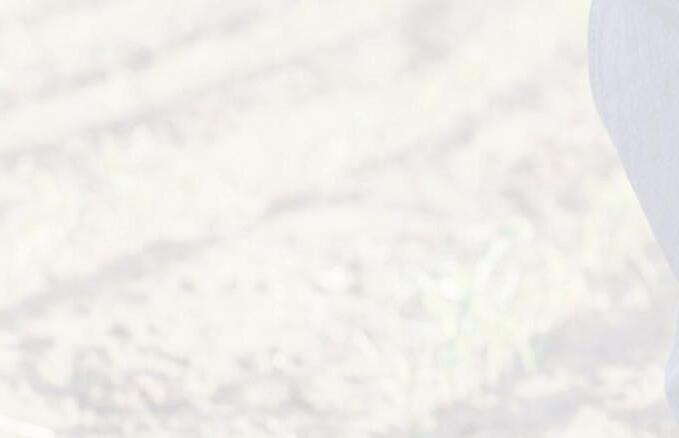



Prescribed Burn Associations Provide Valuable Assistance to Landowners

Historically, seasonal fires played an important role in determining which plant species could survive in a given location. Prairies, savannas, woodlands, glades, forests, and even wetlands all benefited from burning. Fires often occurred naturally from lightning strikes. As vast tracts of land were broken up into farms and ranches, fire was suppressed for the protection of property. With the lack of periodic burning, native plant species were displaced by non-native and invasive fireintolerant plants, upsetting the natural ecosystems.
Over the last few years, federal, state and local land and wildlife managers, along with organizations such as the National Wild Turkey Federation, Quail Forever and Pheasants Forever and the Missouri Department of Conservation have worked to educate the public on the advantages of conducting prescribed burns on their properties. Prescribed fire or controlled burning is an affordable and effective management tool to accomplish land management goals including reducing fuel loads to reduce the intensity and chance of wildfire, restoring native plant communities, enhancing wildlife habitat, improving livestock forage production, regenerating forest lands and controlling invasive species.
For landowners who want to add prescribed burns to their management plan, the amount of manpower and resources needed to conduct a safe and effective burn can seem overwhelming. It was through the need for better landowner resources that the idea of forming prescribed burn associations was born. A prescribed burn association, or PBA, is made up of a group of local members who get together and form an officially recognized 501 (c) (3) with a board, bylaws and guidelines. Members pay dues agreed upon by the PBA to help fund equipment and operating costs.
Funding for wildland firefighting equipment can also come from grants, gifts, loans, the NWTF, QF, PF, the MDC and federal agencies, such as the US Fish and Wildlife Service. Equipment needs for each PBA will vary based on the specific needs of each group and the area where they operate. Most PBA’s purchase an enclosed trailer to house basic firefighting tools that can be brought directly to the site of a member’s prescribed burn. Missouri has local and regional land management experts that can help with planning the purchase of tools and equipment.
If there currently is not a PBA in the area where you reside, you can reach out to the Missouri Department of Conservation or a local land resource manager for contacts. They can put you in touch with people who can help set up an initial exploratory meeting to gauge interest in forming a PBA in your area. Most PBAs are kept small, consisting of only a few counties or a small region. This keeps resources and manpower from being spread too thin.

Whether you join an existing PBA, or are part of a new one, it is important to learn some of the basics of doing a prescribed burn before you schedule one on your property. Missouri has an on-line course to learn about prescribed fire, along with live fire training. By completing the course, students will be certified to write a burn plan and conduct prescribed burns. Membership in a PBA is dependent on completing the course. Your area land resources manager, local fire department and other experienced PBA members can help with putting a fire plan together. You will need to consider a description of the area to be burned (a map can be helpful), firebreaks, the minimum number of participants needed, necessary weather conditions, neighbor notification and a safety plan.
Once a plan is in place and a date and time are chosen, the word goes out to the PBA to see what volunteers and extra equipment would be available. If there is sufficient help, then the burn can proceed. If weather conditions change and the burn cannot go through on the agreed upon time, then it will need to be postponed. PBA members can often supply extra four wheelers, UTV’s and personal wildland firefighting equipment in addition to what is in the trailer.
Missouri currently has 18 PBA’s throughout the state. More PBAs are currently being formed as the news continues to spread about their benefits and how they can contribute to the success of land management through prescribed burns.
To learn more about PBA’s, contact the Missouri Prescribed Fire Council at moprescribedfire.org
Seasonal fires played an important role in determining which plant species could survive in a given location. (Photos: Courtesy of Mark Twain and Foothills PBA's)
Mike Capps

Golden Prairie: Recognizing 50 Years as a National Natural Landmark
This year is the 50th anniversary of the Missouri Prairie Foundation’s Golden Prairie as a National Natural Landmark. The National Natural Landmarks Program recognizes and encourages the conservation of sites with outstanding biological and geological resources.
Sites are designated by the Secretary of the Interior for their condition, illustrative character, rarity, diversity, and value to science and education. The National Park Service administers the program and works cooperatively with landowners, managers, and partners to promote conservation and appreciation of our nation’s natural heritage.
Golden Prairie, in Barton County outside the town of Golden City, was one of 29 sites across the country, and one of five in Missouri, recognized with this national distinction on May 15, 1975. The other four in Missouri that have also been National Natural Landmarks for 50 years are Pickle Springs Natural Area and Taberville Prairie Natural Area, owned by the Missouri Department of Conservation; Tucker Prairie Natural Area, owned by the University of Missouri; and Wegener Woods, an original forest community owned by a private individual.
When designated, Golden Prairie was 320 acres. Since then, two other tracts have been added to this MPF property, now 630 acres. The original 320-acre portion of Golden Prairie is also a designated Missouri Natural Area, a distinction indicating that it is one of the best, last remaining natural communities of its type in the state. The entire 630 acres of Golden Prairie is within the Golden Grasslands Conservation Opportunity Area and the Golden Grasslands Important Bird Area.
Golden Prairie is a dry-mesic sandstone/shale prairie natural community and includes rare prairie swales and a segment of a prairie headwater stream. Golden Prairie supports 320 native plant species, including 35 that depend on intact remnant habitat.
Species of conservation concern documented here include the regal fritillary butterfly, prairie mole cricket, rattlesnake-master borer moth, and Arkansas darter. Grassland birds including the northern bobwhite and Henslow’s sparrow nest here, and short-eared owls frequently use Golden in winter. In addition, notable native bees that are specialists on poppy mallow and blue sage have been documented at Golden. Learn more about Golden Prairie’s history at moprairie.org/project/ golden-prairie/
In recognition of this 50th anniversary for Golden Prairie, MPF will host its annual Evening on the Prairie event here in the fall. Watch moprairie.org for details.
Carol Davit, Executive Director of the Missouri Prairie Foundation & Editor of Missouri Prairie Journal
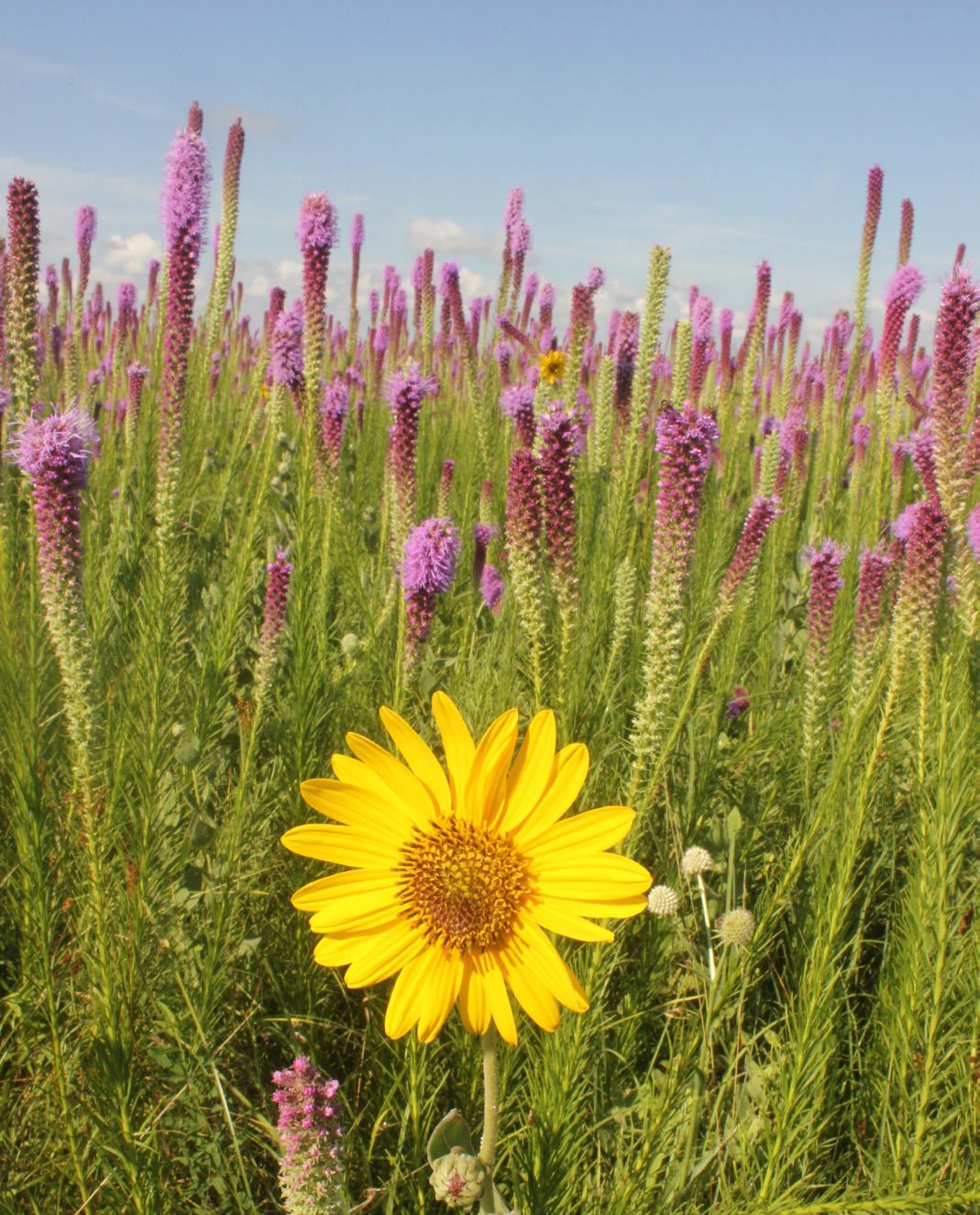

Cover - A young butterfly enthusiast explores Golden Prairie during a Missouri Prairie Foundation event with Phil Koenig, a butterfly and moth expert. You can help document the native species of this original, unplowed prairie by participating in the Missouri Prairie Foundation’s Golden Prairie iNaturalist project. (Photo: Noppadol Paothong/MDC)
Top - Prairie blazing star and ashy sunflower at Golden Prairie in July. (Photo: Bruce Schuette)
Bottom - Sedge wrens occur on Golden Prairie, favoring the sedge-filled prairie swales on this old-growth, unplowed prairie. (Photo: Bruce Schuette)

Road trip. We didn’t choose the perfect playlist. Or program the GPS. But we did fuel the car that made you realize there are no wrong turns, only new adventures. When the energy you invest in life meets the energy we fuel it with, amazing journeys happen.
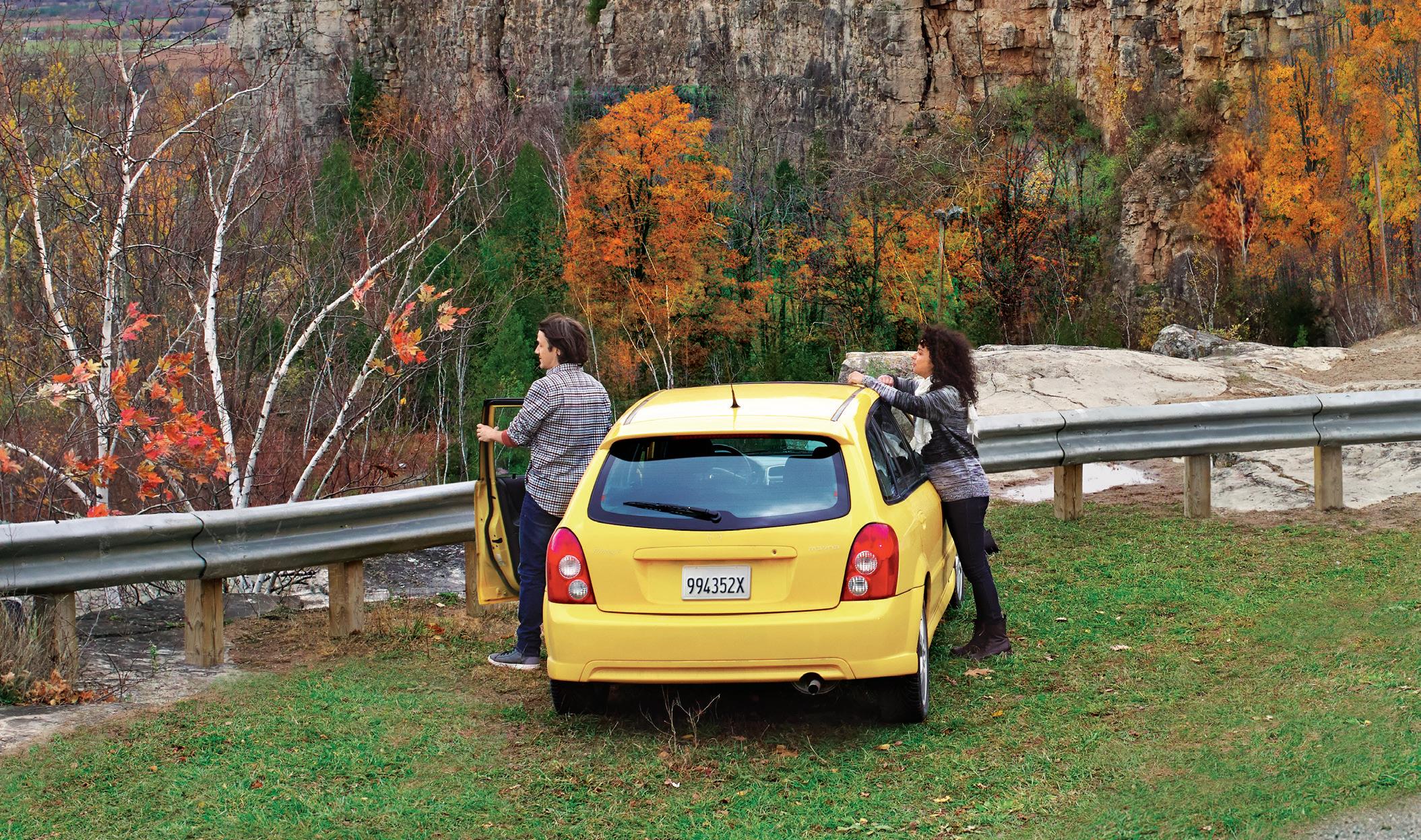

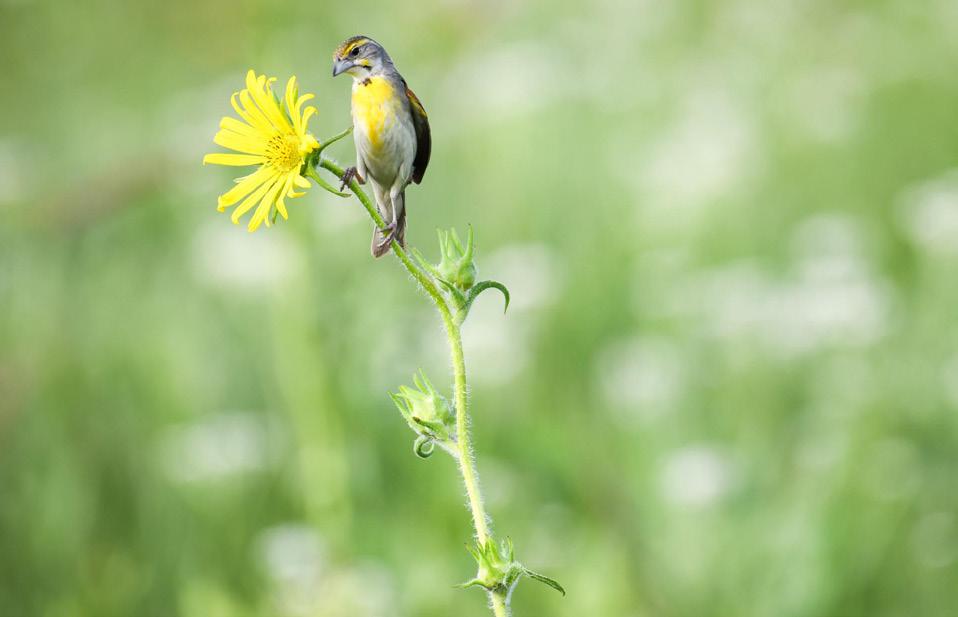
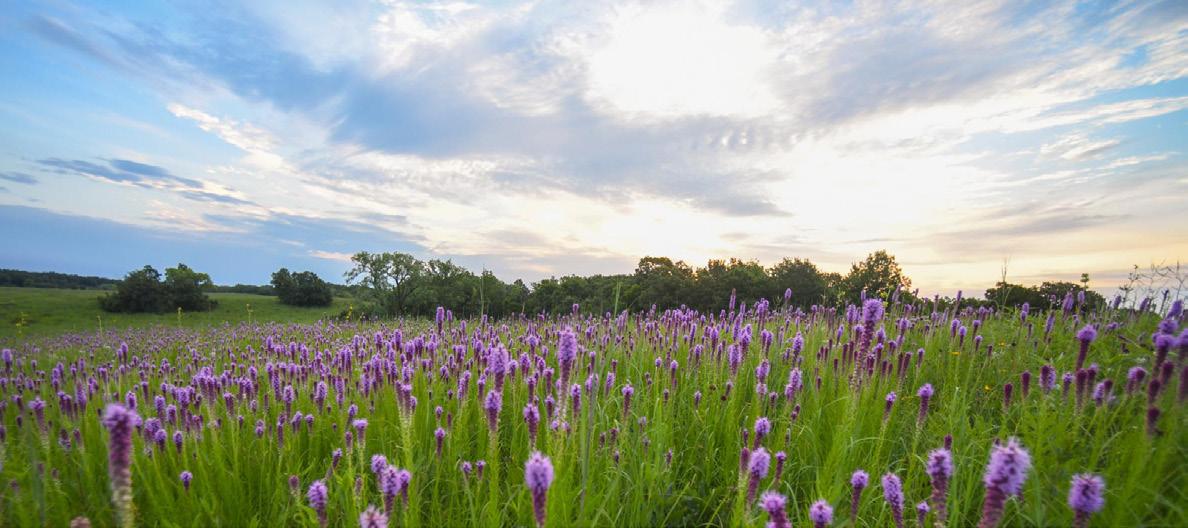
GOOD FOR LAND. GOOD FOR LIFE.
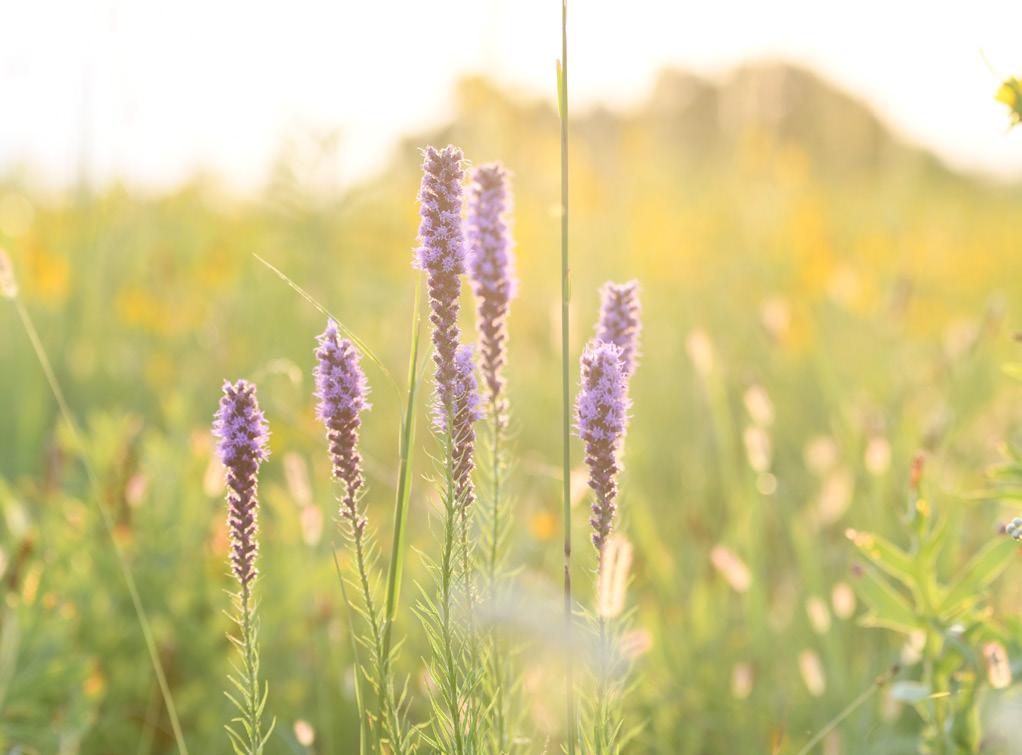
Prairie Prophets is a media platform created by Roeslein Alternative Energy to showcase the stories and objectives of the USDA Climate Smart Commodities Grant.
Everything profits from prairie. Soil, air, water - and all kinds of life! Learn how you can make the most of your land with prairie restoration, cover cropping, and prairie strips.
Explore the Prairie Prophets podcast, video series, website, and socials.
Scan the QR code to learn more.

Schwartz, Leopold, and the Almanac
On a cold snowy day in February, Charlie Schwartz was on my mind. For those unfamiliar, Charlie was, at the very least, a biologist and artist known widely in Missouri conservation circles and elsewhere. His wife, Elizabeth (Libby), formed the second part of a very prolific team. True conservation icons. And during my February ruminations I wondered about the relationship between Charlie and another legend, Aldo Leopold. A relationship that led to a collaboration culminating with Leopold’s wonderfully written essays of A Sand County Almanac punctuated by the exquisite sketches created by Schwartz.
My curiosity was aching and so the journey began. I figured the Leopold Archives, available through the Aldo Leopold Foundation, Inc. would give me all I needed to know. The archives are remarkable, voluminous, and well-organized, and with a little effort I found the rabbit trail I was seeking and so much more.
The story, rich in detail, was more than expected. As I paged through the many documents, I found wonderful letters written in rapid succession. Eloquent and succinct. Letters often passing each other enroute. Letters exposing the relativeness of time when compared to today’s standards, responses written quickly yet moving slowly to their destination. Written with great forethought, deliberation, and fullness.
For this article I had to make choices. There was simply too much, enough for a book. And so, I share a snapshot of the story in their own words, my curiosity partially satisfied.
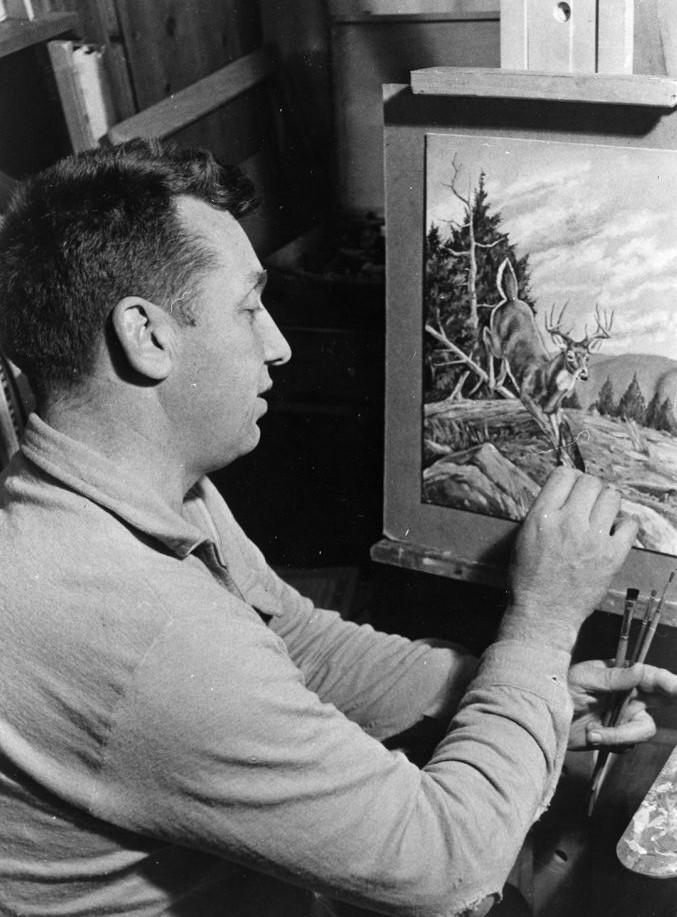
January 3, 1947 - The first mention I found of Charlie being considered for the job of illustrator for the Leopold project was in a letter from Aldo to his son Luna. Aldo writes, “I think your idea of getting Charlie Schwartz for the essays is excellent and I wish you would go ahead with him and feel out the possibilities.”
There had been some conversation around this idea previously. Aldo was simply following up with Luna. “I would be agreeable to almost any kind of arrangement which meets his wishes and needs and I am thoroughly convinced that he will understand the essays and might even improve on our ideas on how they should be handled.”
An interesting backstory is also revealed. Apparently Charlie was butting heads with the Missouri Conservation Commission at the time. “Your account of Charlie's difficulties with the game Commission is very illuminating and certainly far from encouraging. This is the second time I've uncovered the attitude that a species is not worth saving if it furnishes neither hunting nor tourist bait. I know of no stronger evidence of ethical bankruptcy in wildlife administration.”
Another revealing passage from the letter is Aldo’s acknowledgement of Libby’s role as part of Schwartz team, a progressive view for the time and something I attribute to Aldo’s past experience working with Fredrick and Francis Hamerstrom. Aldo clearly wanted Libby to be completely on board with the project. “It hardly needs to be said that Libby as well as Charlie should feel convinced that the essays are a good bet.”
June 25, 1947 – In the time since the January consideration with Luna, Charlie has expressed and communicated some interest in the Leopold project. The Leopolds have invited the Schwartz’s to visit them in Wisconsin.
Writing on letterhead from the “Territory of Hawaii” where Charlie is working for the Board of Commissioners of Agriculture and Forestry, this letter details his future plans with hopes of getting together with Aldo and his wife Estella in the not-too-distant future. Charlie, in a self-deprecating style, mentions his willingness to try to work on the project, stating “…I am conscious of so many limitations that I cannot assure my work will be satisfactory.”
Charlie also thanks Aldo for recommending him for the position of Chief of the Division of Information and Education of the Wisconsin Conservation Department. Charlie declined the position because he did not have time to prepare for the competitive exam required for his consideration.
August 5, 1947 - Charlie and Libby have been busy moving back from Hawaii, visiting family and friends, finding a new home and settling into a new routine. As a result, they’ve not been able to visit with the Leopolds but Charlie heard of Aldo’s impending visit to Missouri for the dinner in honor of E. Sydney Stephens.
In this letter, Aldo expresses willingness to meet with Charlie in St. Louis. Aldo writes, “I will you send you the essays within a week.” These are drafts for Charlie to review and inspire his interest. Aldo also writes, “I suggest you read Louis Halle’s Spring in Washington mainly to look at Jacques’ drawings.”
This recommended book, described as a nature journal, was published in 1947. Louis Halle was an official with the U.S. State Department, and also a naturalist and avid birder. The book’s illustrator was Francis L. Jacque, an accomplished wildlife artist from Minnesota. It seems this book and illustrations left an impression on Leopold.
August 20, 1947 - Charlie confirms a meeting date with Leopold on September 14 and regrets not being able to travel to Wisconsin in the near future buts hopes to do so at a later date. Charlie also appreciates the work of Francis Jacque. “I was very much impressed with Jacques’ drawings in “Spring in Washington…I have followed and admired his work for some time and have a collection of the books he illustrated for his wife.”
September 17, 1947 - Aldo writes, “I greatly enjoyed our visit and I am much pleased with your interest in our common problem.” The common problem is the essays. Charlie is on board and the project is moving forward. Leopold is sending a phenology paper for background research to aid in the development of the sketches as well as some photographs.
September 25, 1947 - In this letter, Charlie thanks Aldo for sending him the phenology reprint that he read “with considerable interest” as a source for his drawings for “Great Possessions,” the original title of the book that would later become A Sand County Almanac. Charlie writes, “I have continued reading the essays and hope to gradually accumulate additional reference material for the drawings so I can work on them at any opportunity I have.”
What makes this letter even more special is Charlie’s addition at the top – an ink pen sketch of a mouse peering over a ledge.
October 14, 1947 - Charlie received the Leopold photographs. “The one showing the take-off of a pheasant is exceptionally good,” Charlie notes. “Also, the skunk tracks made a good shot.” Charlie decides to send some of his Hawaii sketches to Aldo as samples of his technique. Both men are still exploring compatibility of words and pictures.
The Schwartz’s are now settled in Jefferson City, MO and mentioned having “an enjoyable” dinner with Nina (Leopold) and husband Bill Elder preceding a seminar he and Libby gave on their Hawaii survey.
November 17, 1947 - Charlie was recently made aware of the rejection of the essays by publisher Alfred Knopf. Leopold was very disappointed by this rejection and particularly the reasons given. In this letter Charlie expresses sorrow for rejection of the essays, offers encouragement, and tells Leopold that his “enthusiasm hasn’t dwindled.”
Charlie also suggests having some illustrations available for “one or two of the essays to accompany the manuscript” when submitted to prospective publishers. “What do you think of this idea?” Charlie asks. This was a great idea by Charlie. He sees the value of the project being presented with illustrations as a way to convey the fuller vision of how it may be ultimately published. It also leads to the moment that convinces Aldo he made the right choice in going with Schwartz as an illustrator.

January 22, 1948 - Charlie informs Aldo that he is sending him a few sketches. Illustrations for Sky Dance and the Upland Plover essay, later titled Back from the Argentine.
January 28, 1948 - Aldo has received the first sketches from Charlie and was impressed seemingly to the point of excitement. Aldo writes: “My family, my staff, my students, and myself are all full of admiration for your drawings. The more I study them the more I like them. In addition to their over-all merit, I like the accuracy of your details even down to the species of grasses suitable for each.”
The fact that Aldo has shared the sketches with so many suggests he was truly impressed and likely excited to see his vision for the illustrations in the book finally coming to life. “There is much debate over which one is the best. Everyone likes particularly the buffalo skull, but hates to see the fluttering woodcock against the sky relegated to second place.”
Leopold then suggests making photographic reproductions to be housed at different locations to guard against loss of all by fire and as a way of showing the publisher how important the sketches are to the essays.
A Sand County Almanac (Photo: Dan Zekor)
Leopold then mentions sending two additional essays for his review, including one called Good Oak which will need “a series of very simple sketches to divide by successive themes treated in the text.” Signed, “With personal regards and thanking you again for the drawings. Yours as ever, Aldo Leopold.”
January 29, 1948 – The next day after writing Charlie, Aldo writes to his son Starker. Dr. A. Starker Leopold, once the deer and turkey biologist in Missouri, now employed by the Museum of Vertebrate Zoology, University of California-Berkley.
Aldo gushes further to Starker about the sketches, “I have received the first batch of Charlie Schwartz’s drawings for the essays. They are a knockout. I really didn’t know that he was that good. You will see them in March. No word yet from the two publishers now on the string.”
April 7, 1948 - Having made prints of the six sketches, Leopold has returned the originals to Charlie and has sent a set to a potential publisher for review. Aldo says, “The longer I look at the drawings, the better I like them.” Aldo is now starting to envision how the publisher may handle inclusion of the sketches and worries some about those decisions once a commitment has been made. Aldo signs off, “With best regards to you and Libby. Yours ever, Aldo Leopold”
April 12, 1948 - In this letter from Schwartz its clear the work on the project has intensified. Charlie has now received essays with sketch inserts and the discussion is focusing on final presentation possibilities including discussion about the technical side of displaying art within the final work. Charlie suggests Edgar Queeny’s “Prairie Wings” and illustrator, Richard Bishop as a reference to help convey ideas and possibilities. He also lobbies for some diversity in how the artwork might be produced stating, “…I hate to conform to the conventions of uniformity.”
Charlie laments being behind on the other sketches. “I've made a few but my whole schedule has been thrown out of kilter in trying to catch up where I left off when I went to Hawaii and still finish the work I promised to do for the Hawaiian government.” He states further, “It looks like I'm alibying and perhaps I am but I'm still going to get your work done.”
Charlie also writes of his excitement working with Edgar Queeny doing film and sound recordings of a prairie chicken booming ground. Charlie states: “Our intentions are to make a good sound movie.”
Charlie then closes the typed letter with a pen written message at the bottom: “The good oak is a good one!”
April 14, 1948 – Oxford University Press to Aldo Leopold: “Dear Dr. Leopold, it gives me very real pleasure to write you now to confirm the substance of our telephone conversation of this morning subject of course to agreement on royalty terms which we did not cover in our talk… It was agreed that we are to publish your book “Great Possessions”, as illustrated by Charles W. Schwartz.”
This letter then discusses the details of printing, royalties, and how Charlie Schwartz might be compensated.
April 16, 1948 – On this day, both Aldo and Charlie wrote one another. These would be the final letters between the two men. The day before, Aldo had wired the good news to Charlie. In his letter, Aldo informs him the book will be published in 1949, allowing for more time for work on the sketches. He also gives full control of how the sketches will be used in the book to Charlie, telling him to talk directly with the publisher.
Charlie’s letter to Aldo - “Dear Aldo, First of all I want to say how glad I am to hear about the publishers acceptance of the essays. That's really swell.” Charlie then makes an inquiry. “Was the oak in “The Good Oak” a black oak? You mentioned a black oak in the text and I wanted to make sure I drew the right kind of acorns.”
On Wednesday, April 21, 1948, Aldo Leopold died unexpectedly. A neighbor’s fire was spreading into the fields, threatening the Leopold plantation. Hurrying with a backpack pump to wet down vegetation to slow the fire’s advance, he would succumb to a heart attack. Laying down with hands folded he would pass away; the fire “swept lightly over his body.”
April 24, 1948 – Dr. Joseph J. Hickey, a past student of Aldo’s and now an Assistant Professor of wildlife management at the University of Wisconsin prepares a confidential memo to a list of people Aldo had previously identified as persons he wished to read the final draft of “Great Possessions.”
The group, called The Reading Committee, forms the nucleus of those who will now move the final project forward to publication. Hickey also writes Charlie, “I presume that Bill Elder has advised you of Aldo’s tragic death from a heart attack on April 21.”
In another letter on April 27, Hickey tells Charlie, “I cannot answer your question about the species of “Good Oak.” Hickey refers him to Bill Elder to confirm identification.
In a letter by Charlie to Hickey written on the same day Charlie writes, “I was glad to get your letter and to know that you have taken up the problem of having the essays published. Needless to say Aldo’s death was a shock and a great loss to us all. I feel it greatly because most of the pleasure in doing the illustrations was trying to communicate to him the same feelings in pictures that he had portrayed in words.”
This letter goes on to discuss particulars about the arrangement between Aldo and Charlie, including the open question of payment. One final excerpt from this letter by Charlie, “I want to make another statement to the committee which I had made to Aldo. I am not a good artist and if in any of my work I have achieved interesting results it is because I drew those things that particularly interested me or that I understood well enough to do. Consequently some of the illustrations will not be easy for me but because I am interested in all of them I will do my best.”
There are many more letters detailing the final steps in the publication of the book. It is remarkable how the final particulars were ultimately worked out, and as I reviewed the remaining correspondence I could sense the emotional weight of Aldo’s death and desire to see this project completed. It’s clear to me that Aldo and Charlie had a relationship based on mutual interest, respect, and trust. It’s also clear the family and others involved also deeply trusted Charlie’s role. I can only hope Charlie was pleased with the final outcome. It’s unfortunate Aldo and Charlie never shared the final moment when the book, A Sand County Almanac was finally published in October, 1949.
Many thanks to the Aldo Leopold Foundation, Inc for use of the material presented in this story.

"There are some who can live without wild things, and some who cannot" - A Sand County Almanac
the Aldo Leopold Foundation)
Dan Zekor
Cover - Charlie in his studio.
(Photo: Courtesy of University of Missouri Archives) Above - Original sketch.
(Photo: Courtesy of
Our Great Outdoors

The opening line of one of my favorite songs says, “God bless America, land that I love.” Another line is, “From the mountains to the prairies to the oceans white with foam, God bless America, my home sweet home.”
I love America’s great outdoors. I grew up in Missouri and still call it my home sweet home. It is a state blessed with natural beauty and abundant places to enjoy outdoor activities. I have also experienced the mountains, prairies, and oceans in many other places in America.
I have hiked and fished the mountain lakes and streams of Colorado, Montana, Wyoming, Idaho, Oregon, and Hawaii. I have walked and fished the beaches of Hawaii, Florida, California, Texas, Maine, and Alabama.
I have enjoyed freshwater lakes, rivers, and streams while fishing in my home state of Missouri. Also, Arkansas, Kansas, Texas, Louisiana, Alabama, Tennessee, Oklahoma, Illinois, North and South Dakota, New York, Florida, and Minnesota. I have made a lot of fishing trips to Wisconsin lakes to fish with our son and his family. I hope there will be more fishing trips there.
My wife and I have been to ten of America’s National Parks. Yellowstone, Glacier, Hawaii Volcanoes, Great Smoky Mountains, Carlsbad Caverns, Mammoth Cave, Rocky Mountain, Acadia, Grand Teton, and Everglades. They were all wonderful places to visit.
The history and majestic beauty of these places will always be in our storehouse of memories. We would love to see all the National Parks before the good Lord calls us home. We better get busy though. There are 53 more for us to visit and they cover 85 million acres.
Still on my bucket list is a trip to Alaska to fish, see Mt. McKinley, and enjoy the culture of that area. There may be a few more fishing or hiking places we might go to, but Missouri is home and like Dorothy said in The Wizard of Oz, “There’s no place like home.”
I hope some of your most pleasant memories will come from our great outdoors. I urge you to fish, hunt, camp, hike, and explore all over America with your family and create memories that will last a lifetime. May a special hiking trip always linger in your mind. May you go on a fishing or hunting trip you will never forget. May you forever remember a once-in-a-lifetime camping adventure.
Feature Story
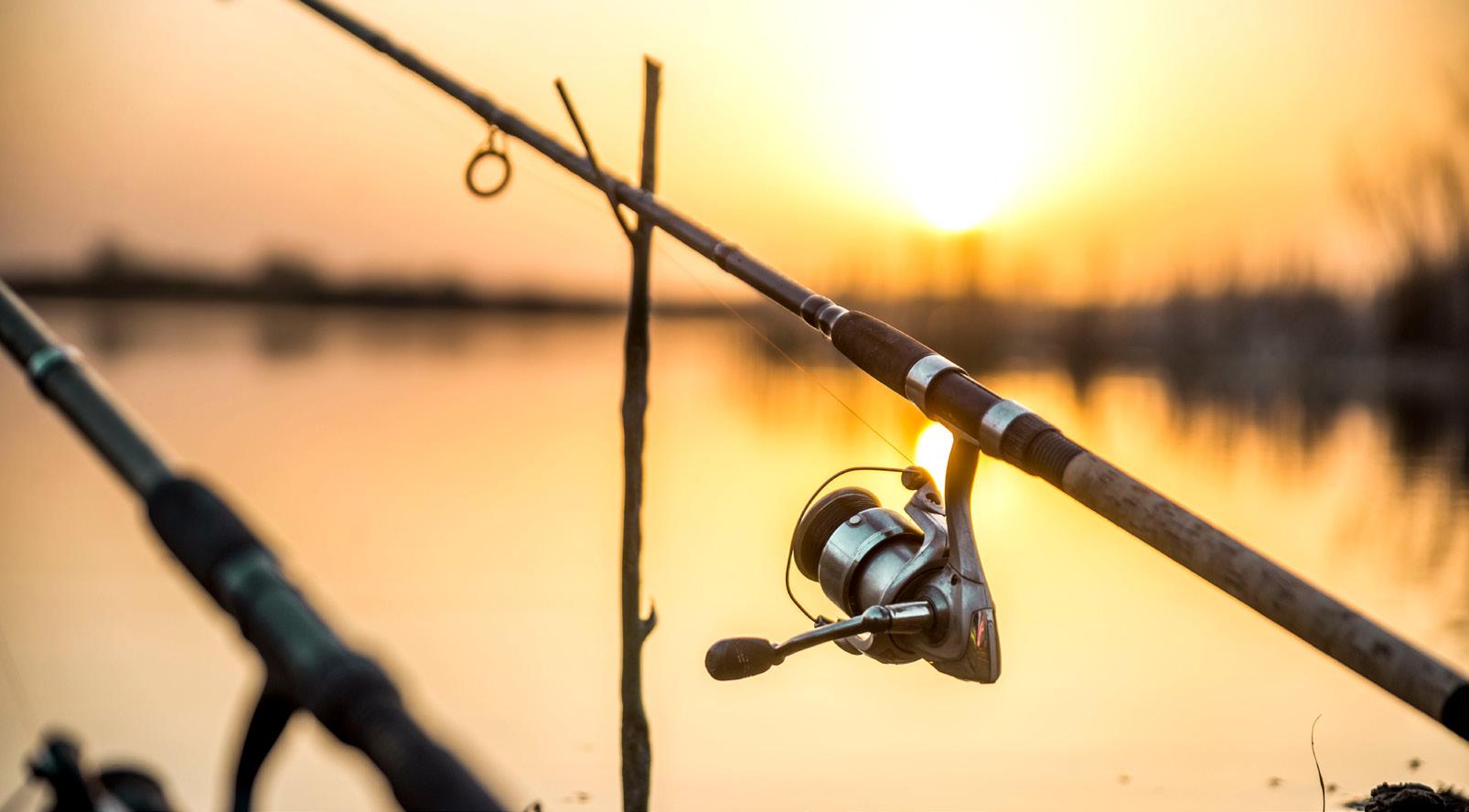
When people from other countries come to America, they marvel at the abundance of fish and wildlife, our many national parks, and all the places we can go to enjoy the great outdoors. Most surprising to them is the availability of these resources to ordinary people. In other parts of the world, only the privileged can walk to a stream and catch a trout, hunt deer, or pitch a tent in front of a magnificent view.
We take our beautiful lakes, streams, oceans, mountains, prairies, and forests for granted. Thankfully, our forefathers knew the value of the Purple Mountains majesty and the fruited plains and made natural resources the focus of their songs and lives.
Here in Missouri, we sometimes forget that we would not have the outdoor opportunities we have without the continued efforts of the Conservation Federation of Missouri, the Missouri Department of Conservation, the Missouri State Parks, the Army Corps of Engineers, and others. We need to thank them and support them in any way we can.
Do the same for the US Forest Service, US Fish and Wildlife Service, Bureau of Land Management, and National Park Service. They are using your donations and tax dollars to benefit your outdoor experiences.
We have our choice of lakes, rivers, and streams to catch fish, paddle or boat around, play in their water, or relax on their banks and listen to the sounds of nature.
We have many forests and prairies to make hunting memories. Campgrounds are waiting for you to come to enjoy sitting around a campfire and listening to a crackling fire and night sounds. Lots of hiking places with magnificent scenic views await your footprints.
They are all places you can go for at least a few days and relax from a hectic work week, either alone or with others. They are places to think and pray. Places to get away from traffic and all the screens you look at all the time. They are places to renew your mind or recharge your body.
The cost is either free or minimal. The physical and mental benefits are many. It is better than a $100-per-hour psychoanalysis for putting our lives into perspective. Every season of the year, I encourage you to get outside and enjoy our great outdoors.
My favorite outdoor quotes is one by Anne Frank that says, “The best remedy for those afraid, lonely, or unhappy is to go outside, somewhere where they can be quiet, alone with the heavens, nature, and God. Because only then does one feel that all is as it should be and that God wishes to see people happy amidst the simple beauty of nature.”
As bad as it may seem at times, we need to thank God we live in America. In America, among other freedoms, we have the freedom to become what we want to be, the freedom to believe what we want, and the freedom to worship as we please.
I cannot imagine our great outdoors was created by some cosmic explosion or evolution. I believe God created our great outdoors for all of us to enjoy and take care of. I have the right, in America, to be bold in telling others what I believe. You have the right to do the same. It is up to each of us to accept or reject.
I love our great outdoors. I also believe God inspired me to be bold in writing this poem to hopefully touch the lives of others.
Whether you are a believer or not, there is one more line from God Bless America I want you to think about. “Stand beside her and guide her through the night with the light from above.” In our broken and divided America, we all need God’s light from above. We all need our great outdoors.
Larry Whiteley
Cover - Take a hike with your family. Left - Watch a sunset on a lake.
Right - Go make a memory with your kids. (Photos: Courtesy of MDC)

God's Almighty Hand
I have had people ask me how I could believe in a God I do not see And his spoken words receive. I smile and explain why I have no doubt. It was God and his great power that brought the great outdoors about.
All I have to do is look around the times when I am there.
I see Him in the sunrise. That is why I am so aware. I see Him in summer rains that nourish the trees and wildflowers. I see Him in a summer star-lit night. What a witness to his power.
I see Him in a campfire as the flames spark and dance. I see Him as a deer sneaks through the woods as I get a fleeting glance.
I see his beauty in the butterfly’s wings, the bronzed feathers of a turkey, the colors of the spring.
I see Him in the sparkling water as I make another cast. I think of all He has done for me so many times in the past. I hear Him in the early light when the birds begin their songs. I hear Him when the thunder rolls and is so loud and strong.
I hear Him when the geese fly high in the sky. I hear Him when an eagle cries. It is something you cannot buy. I feel Him in a gentle breeze as I say a prayer. When the sun shines warmly on my face, I know He is there.
His strength shows in the mountains and the ever-pounding seas. The lightning bugs’ twinkling lights show his love for me. If you will only stop, look, and listen when outdoors on the land. You will see, hear, and feel that it was all created by God’s mighty hand.
DEPARTMENT OF CONSERVATION
MDC Advises Boaters to Beware of Hitchhikers
As boat owners and water enthusiasts hit Missouri lakes and rivers, the Missouri Department of Conservation (MDC) warns boat owners to be on the lookout for the infamous invasive zebra mussel.
Zebra mussels are an invasive species that came to North American waters in international shipping ballast water and were first discovered in Lake St. Clair near Detroit in 1988. Zebra mussels were first reported in Missouri in 1991 in the Mississippi River near St. Louis. They have spread to the Missouri, Osage, and Meramec rivers, and streams downstream of infested lakes.
They have also been found in the following Missouri lakes: Blue Springs Lake, Bull Shoals Lake, Carrollton Recreation Lake, Lake Jacomo, Lake Lotawana, Lake Taneycomo, Lake of the Ozarks, Longview Lake, Prairie Lee Lake, and Smithville Lake. Just because a river or lake does not have a known infestation of zebra mussels does not mean that they are immune, and the public is encouraged to watch for the invasive mussels.
Invasive zebra mussels hurt native fish numbers and disrupt aquatic ecosystems. They decimate populations of native freshwater mussels and other aquatic animals. Zebra mussels can clog power plants, as well as industrial and public drinking water intakes, foul boat hulls, and motors.
One of the greatest risks for spreading the invasive mussels to other lakes and rivers is overland transport on boats, motors, trailers, docks, aquatic plants, pumps and other equipment. Larger adult zebra mussels can live several days out of water in moist, shaded areas. Microscopic zebra mussel larva can survive in boat bilge water, livewells, bait buckets, and engine cooling-water systems.
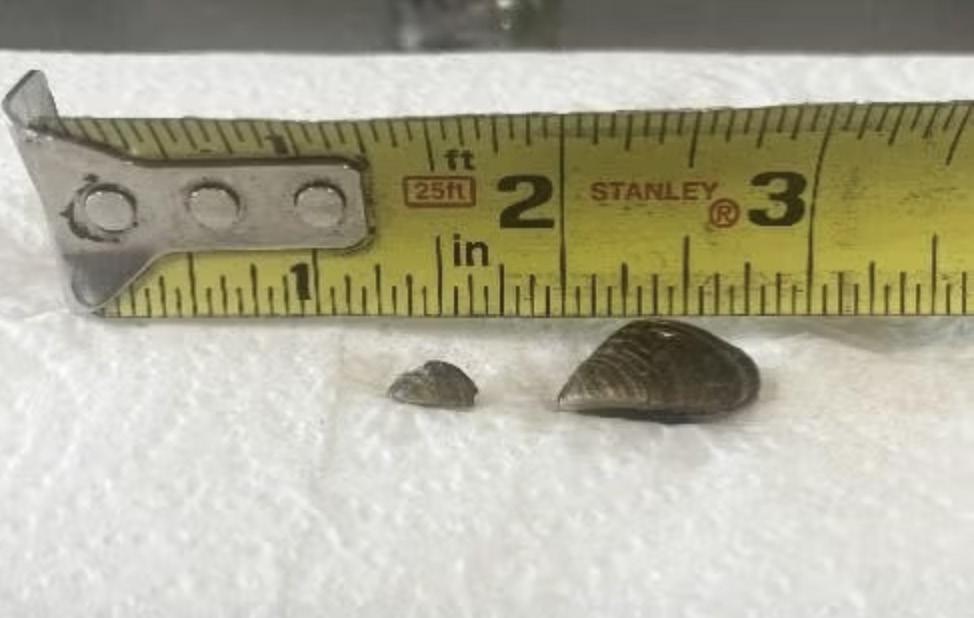
MDC urges boaters to keep their crafts and equipment free from hitchhiking zebra mussels -- especially when moving between waterbodies -- by completing the following steps:
• CLEAN — Remove all plants, animals, and mud and thoroughly wash all equipment, especially in crevices and other hidden areas. If the boat or equipment was used in infested waters or if it has attached adult mussels, use a HOT (104-degree Fahrenheit) water spray.
• DRAIN — Eliminate all water before leaving the area, including livewells and transom wells.
• DRY — Allow enough time for the boat to completely dry before launching in other waters.
• DISPOSE — DO NOT dump unused bait into lakes, ponds, rivers, or streams. Put unused bait in a trash can.
Learn more about zebra mussels at www.mdc.mo.gov/ fishing/protect-missouri-fishing/zebra-mussels.
MDC asks boaters and others to report zebra mussel findings to their nearest MDC regional office, including from known infested lakes and rivers.
The 2025 Missouri National Archery in the Schools Program
The 2025 Missouri National Archery in the Schools Program (MoNASP) State Archery Championship was held March 19-22 at the Branson Convention Center and drew more than 4,000 student archers in grades 4-12 from nearly 300 Missouri schools. The championship was sponsored and coordinated by the Missouri Department of Conservation (MDC) and the Missouri Conservation Heritage Foundation (MCHF).
The event included both a bullseye competition with 3,852 archers and a 3D competition with 1,770 archers, with some participants competing in both. Archers who ranked in the top 10 for their division, as well as the top ranked schools, will be eligible to move on to the Eastern or Western National Archery in the Schools (NASP) tournaments.
“The turnout for MoNASP was fantastic as the program has grown in recent years,” said MDC MoNASP Coordinator Rob Garver. “We’re happy to see so many students enjoying the sport and seeing their confidence grow in their archery skills, as well as in their schooling.”
MoNASP is coordinated through MDC, MCHF, Conservation Federation of Missouri, and the National Archery in the Schools Program in partnership with more than 800 participating schools and numerous supporting organizations throughout the state. More than 83,000 student archers are participating in the program, and more than 200,000 Missouri students have participated since it started.
MoNASP is an affiliate of NASP and is an in-school program for grades 4-12 that teaches the basics of archery, along with the confidence, self-control, patience, and discipline necessary for success both behind the bow and in school and life. It provides an engaging activity that’s inclusive of nearly all children, regardless of age or physical ability. Statistics show school archery programs improve students’ school attendance, increase their selfesteem and physical activity, and help kids get outside.
Bullseye Competition Top Individuals From Each Division
• Kendall Webb, Siegrist Elementary School in Platte City – Score 282
• Luke Scheulen, Osage County R-2 in Linn – Score 284
• Makenzie Humphrey, Blair Oaks Middle School in Jefferson City – Score 293
• Oliver Heckman, Fatima Middle School in Westphalia – Score 293
• Caydence Hall, Helias High School in Jefferson City – Score 294
• Wade Conner, Hillsboro High School in Hillsboro – Score 296
Bullseye Competition Top Teams
• George Guffey Elementary School in Fenton –Score 3162
• Ridgewood Middle School in Arnold – Score 3307
• Hillsboro High School in Hillsboro – Score 3427
• Get all bullseye competition results online at http://short.mdc.mo.gov/4jD.
3D Competition Top Individuals From Each Division
• Kendall Webb, Siegrist Elementary School in Platte City – Score 269
• Wyatt Dorge, St. Joseph Catholic School in Westphalia – Score 276
• Marit Bredesen, Bernard Campbell Middle School in Lee’s Summit – Score 287
• Wyatt Clancy, North Wood R-IV School in Salem –Score 290
• Jenna Guerin, Sparta High School in Sparta –Score 289
• Wade Conner, Hillsboro High School in Hillsboro – Score 297
3D Competition Top Teams
• Carl Junction Intermediate School in Carl Junction – Score 1506
• Sarcoxie Middle School in Sarcoxie – Score 1683
• Hillsboro High School in Hillsboro – Score 1728
• Get all 3D competition results online at http:// short.mdc.mo.gov/4jK.
To learn more about MoNASP, or to enroll your school in the program, visit https://education.mdc.mo.gov/schoolprograms/monasp.
The MoNASP State Archery Championships were held March 19-22 in Branson. Pictures are the high overall archers in the Bullseye and 3D Tournament.
Spirit Trail MISSOURI STATE PARKS
Spirit Trail has been a decades-long trail project in Johnson County, Missouri, and its further development will likely never end given the level of dedication focused to help create the first 10.3 miles. Thirty years ago, in 1995, Warrensburg residents as well as Whiteman Air Force Base personnel had a shared interest in a biking and hiking trail to connect the two communities. Their shared interest started with Phase 1, which was completed in the late 1990s from Highway 13 to the Lake Ridge community within the city limits. Whiteman Air Force Base also created its section of Spirit Trail within Royal Oaks Golf Course next to the base. Although this phase did not fully connect the two locations, it did allow for the paved trail to spark the interest and devotion of a generation of trail enthusiasts.
A loosely formed coalition of area residents and trail users kept the interest alive for additional development, yet nearly 15 years passed before the spark was ignited again. In April 2012, Johnson County residents and Missouri State Parks’ executive team met at Camp Bobwhite, an organized group camp at Knob Noster State Park, to discuss the next steps of pushing Spirit Trail farther east.
A first step was the formation of the Johnson County Trail Coalition. The coalition continued offering direct guidance for the trail’s development. Before the coalition’s formation, the asphalt trail running parallel to Highway DD had no name, yet its popularity was evident given the number of visitors using the trail for hiking and biking. Within a year—through a community-driven naming effort—the trail was given the official designation of “Spirit Trail” in recognition of the B-2 Spirit bomber stationed at Whiteman Air Force Base. Representation on the coalition also offered a testament to the trail’s popularity and the enduring theme of connecting communities. Organizations involved included the Johnson County Commission, local municipal governments, Missouri State Parks, University of Central Missouri, Pioneer Trails Regional Planning Commission, state legislators, Missouri Department of Transportation, and Whiteman Air Force Base.
By the end of 2012, the coalition had developed a formal four-phase plan to reach Whiteman Air Force Base and the City of Knob Noster. With multiple funding sources, construction began in August 2017 due to the cooperation of the Missouri Department of Transportation, Great Rivers Engineering based in Springfield, Missouri, and Build-it Construction out of Nevada, Missouri. The construction of the new section was finished in October 2018, and a ribbon cutting for the completed eastern section of Spirit Trail was held on Oct. 16, 2018.
From late 2018 to 2022, the coalition continued meeting each month to plan additional next steps for completing its goals. One goal was painting the retaining wall positioned along Bristle Ridge, the highest point along Spirit Trail. The wall offered a unique blank concrete canvas to help reinforce the trail’s primary focus of connecting communities. So, in the spring of 2021, the coalition created a contest for area artists. From numerous submittals, Stefanie Aziere-Sattler was selected because her design illustrated elements important to Johnson County: railroad history with MKT and Rock Island railroads, the importance of the mule as part of this area’s efforts to win World War I, the Old Drum legal case, the history of the University of Central Missouri, indigenous peoples—such as the Osage—who originally lived in this area, as well as the history of Whiteman Air Force Base.
Another goal was to secure funding for Knob Noster State Park’s portion of Spirit Trail. In 2022, $4 million was secured through the Missouri State Parks capital improvement process in cooperation with thenState Sen. Denny Hoskins. This funding allowed for construction to start in October 2023, which used the park’s plan created in 2015 by the design firm Bartlett and West based in Jefferson City, Missouri. The park’s section would include several complex factors due to a shared portion with McAdoo Trail, a highway crossing, one 150-foot-long bridge, and three surface conditions: concrete, asphalt, and aggregate. Each surface type was chosen depending on the terrain, the cost, and the planned user type.

Through cooperation with the Office of Administration, FlowMaster Construction based in Mexico, Missouri, and Missouri State Parks staff, the park’s section of Spirit Trail was completed by early November 2024. On Nov. 7, 2024, a ribbon cutting was held at the Clearfork Day Use Area to celebrate the opening of the section. Coalition Chair David Peerbolte offered a positive reminder at the event: “It began as a vision for alternative transportation with the desire to connect communities and recreational possibilities.”
Additionally, Whiteman Air Force Base’s 509th Bomb Wing commander Col. Keith Butler encapsulated the trail’s long-term planning, construction, and continued support by stating, “We now have a beautiful trail for our airmen and our families, and this is not the end. We’re on to the next (trail) project now. On behalf of everyone associated with Whiteman, this is much needed.”
In mid-2024, Whiteman Air Force Base personnel had completed another goal: repaving the 3/4-mile portion through Royal Oaks Golf Course. From Spirit Gate, which is the base’s main gate and Spirit Trail’s eastern terminus, to the western terminus at Highway 13, the trail is now 10.3 miles long.
With all the accomplishments made in the last two years, the coalition’s vision of connecting communities still burns strong. In 2025 and beyond, the coalition will focus on additional trail surface to the City of Knob Noster, and to Leeton and Chilhowee to connect Spirit Trail to Rock Island Trail State Park. The work is planned to prepare for the next generation of leadership as well as to work with the coalition’s current partners to ensure the trail stays in great condition.
Considering the number of positive connections between numerous governmental organizations, area residents, businesses, and donors, Spirit Trail is a case study on how strong interactions, dedication, and patience can bolster and expand the interdependence of communities striving to better themselves.
To learn how to participate in further development, please reach out to: spirittrail.org/contact.
Daniel Brigman




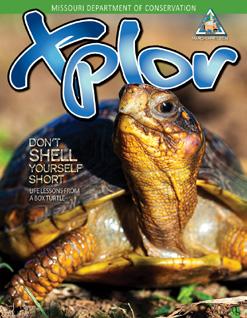


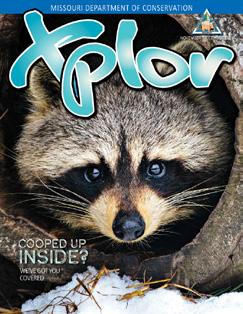
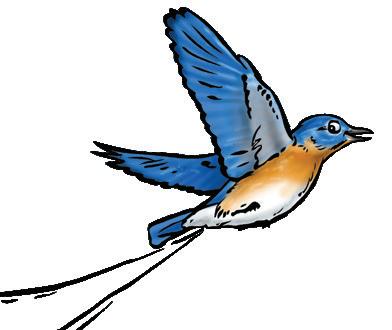

Looking for a way to coax your kids to unplug, climb off the couch, and get outside? Then check out Xplor, the Conservation Department’s free magazine for kids and kids at heart. Six times a year, Xplor serves up eyepopping art, photos, and stories about Missouri’s coolest critters. The magazine is free to Missouri residents (one subscription per household, please). Outof-state subscribers pay $7 per year; out-of-country subscribers pay $11.
at




The Sentinel
Iwas sitting under the silver maple tree in our backyard drinking my morning coffee. This spreading maple is an excellent place to ease into my day on warm mornings. The tree was about 12 feet tall when we moved into our house in 1978. Now it is over 60 feet tall with a diameter of about four feet and shades most of the backyard. For some reason, I think of this tree as always being huge and I have to look at photos from decades ago to remind myself of its original size.
Since daydreaming and recreational thinking are two of my favorite pastimes, the shade and solitude of the maple tree provide an excellent environment for these activities. Many of my articles for this magazine coalesced in my mind under the shade of the silver maple. I would sometimes retreat to the shade of the maple tree when Mrs. Urich and I occasionally had minor martial skirmishes. The maple tree was never judgmental but was always sympathetic, supportive and an attentive listener.
On this day, I was gazing at three huge dump truck loads of 1-inch road rock piled in front of Mrs. Urich horse barn and indoor horse-riding arena. The rock needed to be spread around the barn, riding arena and on the drive from the county road. For reasons I never completely understood, the ground keeps swallowing the rock requiring more after a period of time. Mrs. Urich doesn’t like mud around her horse facility, which has impacted our family dynamics for over 30 years.
In the past, I was unconcerned about how much and how frequently rock needed to be refreshed around her buildings because we had three teenage sons who handled this task. Every year after school was out for the summer, I had a dump truck full of road rock delivered and dumped on my spot. This rock remained on my spot until one of our sons committed crimes against the family or society. The offender got to move the rock to Mrs. Urich’s spots which were all uphill and accessible only by wheelbarrow.
Typically, it took about three days to move all the rock, longer if it was hot and humid outside. I liked the temperature to be over 90 degrees, which helped our sons evaluate alternative behaviors for making better life choices. We called the rock pile the sentinel of good behavior. There was never a problem with the sentinel not being moved. Occasionally, I would order a second truck load of rock if the sentinel was moved early in the summer. This second pile rested quietly on my spot, serving as another sentinel of good behavior.
One year, our middle son, Aaron, volunteered first to move the sentinel. Mrs. Urich wanted all the road rock distributed in her horse barn and rubber stall mats placed over the rock to keep the dust down and make cleaning up easier. Of course, each stall would need a drain and Aaron got to dig the trenches for the drainpipe before moving the sentinel. We did this job together so I could show Aaron how to glue PVC pipe together and install the pipe in the ground at the correct angle for drainage. I felt it was important to teach our sons the basics of home repair and remodeling because, at some future point, they would have homes of their own.

My major resource for home repair guidance was a large, oversized book titled the Reader’s Digest Guide to Home Improvements. I supplemented this book with a 1972 copy of How to Be Your Own Home Electrician because it had very clear diagrams on wiring switches, outlets and lights. I didn’t realize that in about 15 years, the internet would be packed with videos on how to do and repair everything, making my references obsolete.
The hardest part of this barn project was installing the 4 x 6-foot rubber stall mats which weighed about 70 pounds. They were difficult to move because they were so flexible. I had to draft our other two sons to help who complained this was Aaron’s job to atone for his transgressions. I overruled their argument, explaining helpfulness was an essential personal attribute, and sometimes it was important to be supportive regardless of the circumstances. Of course, most of the mats had to be cut to fit which was a very difficult task. After lengthy experimentation, I finally determined that a skill saw blade installed backwards did the best job.
About every other year, I would get my 1947 Farmall tractor stuck in the mud during the spring on our 40 acres the result of carelessness on my part. Those summers I didn’t have to order a load of rock because one of my offending sons would be assigned the task of digging out the tractor. This was a more massive assignment than moving the sentinel and could take a week depending on how badly it was stuck. The problem was this old tractor transferred power to the rear wheel, slipping the most, which required a massive amount of digging to free it.
Cover - Tim, Kirk and Aaron Urich after spending 6 months digging 107 holes for an outdoor horse-riding arena.
Right – Kirk Urich moving the sentinel of good behavior.
(Photos: David Urich)
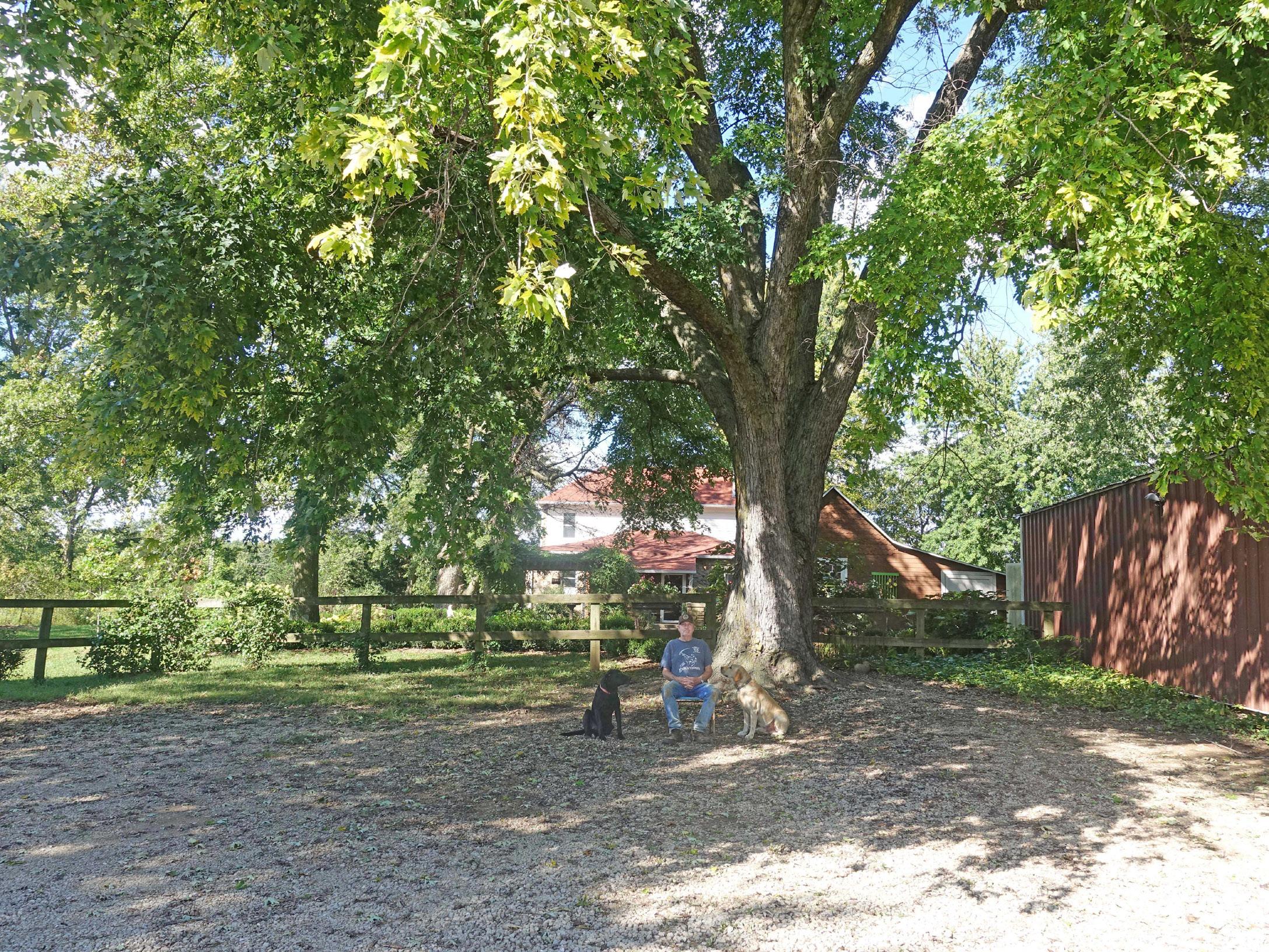
Of course, this crater had to be filled in when the tractor was unstuck. Our sons complained bitterly they should not have to suffer because of my negligence. I totally agreed. All they had to do was not come home with a conduct slip for me to sign for unacceptable behavior at school or on the bus. I would dig out the tractor myself. Their behavior was noticeably improved when the tractor was buried in the mud. Occasionally, it took almost 3 weeks before a volunteer stepped forward which was inconvenient when I needed the tractor for other purposes.
I never bonded with any of Mrs. Urich’s horses and they were a complicating factor in my life eating up my free time better spent daydreaming under the spreading maple tree or fishing on the Missouri River.
But her horses and horse facility were an endless supply of difficult tasks for our teenage sons. There are four frost free hydrants associated with her buildings. I had a backhoe dig the water lines and our sons helped me install the pipe. I told our sons it would cost $75 to have the backhoe return to fill in the trench but I would give them this amount instead if they wanted to do the work.
This was a huge amount of money and they jumped at the chance. I misrepresented the cost of the backhoe, but it is acceptable for parents to stretch the truth for the greater good. I learned early in the parenting process our sons got into a lot less trouble when their hands were wrapped around the handle of a shovel, pick or posthole digger.
Three days later they finally finished but I weakened and gave them 20 extra dollars for doing such a good job. Parenting is all about rewarding success.
Mrs. Urich wanted a large outdoor riding arena with a wooden fence requiring 107 post holes. I assembled our sons and told them I would rent a posthole auger for the tractor provided none of them came home with a conduct slip for me to sign. The offender would be issued six holes, 28 inches deep. It took almost six months, but our sons dug all the holes by hand. Then Mrs. Urich discovered the size was not big enough for an official dressage arena and the posts on one end had to be removed and reset to make more room.
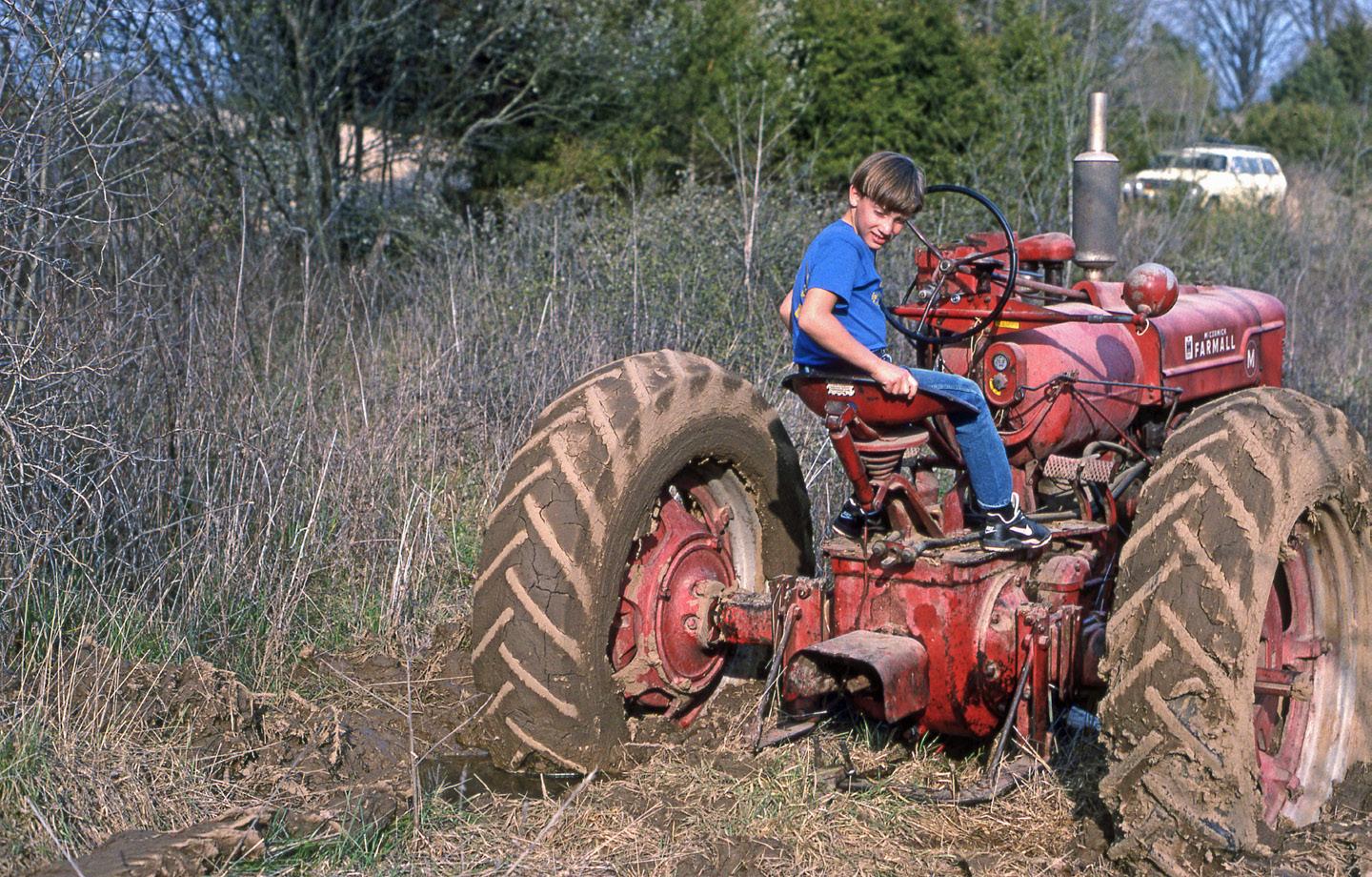
Our sons took this news poorly and felt it was unfair to make them do extra work because Mrs. Urich got the measurements wrong. They had a good point. Parenting is all about fairness, so I helped with the digging and also provided a cash incentive, which took the edge off their bitterness. They were always more enthusiastic when they could dig for dollars. Our oldest son asked why Mrs. Urich was not helping dig since she got the measurements wrong. I told him to hold that thought because the answer would be more understandable and apparent after he was married for a few years.
It is during the spring hay season we sincerely miss the contribution of our teenage sons. They could stack 110 square bales on a 16-foot flatbed trailer in 30 minutes. I can barely get 50 bales on the trailer if I struggle. All of our friends disappear or suddenly have other commitments when hay bales are on the ground. It has been impossible to hire teenagers to help in recent years.
Last spring, Mrs. Urich drove the truck with the trailer, and I handled 414 square bales. It took 3 days. I took pictures and sent them to our sons so they could appreciate how their elderly parents suffered without their help. There were no responses, expressions of sympathy or offers to help next spring. Sadly, the horses will eat all the hay, poop it out and want more next spring.
My thoughts gradually returned to the present and my focus reverted to the huge pile of rock which was still there glaring back at me. Our sons have moved away and have successful careers, families and homes of their own. They don’t come around much probably because they know the house, horse facility and the entire 40 acres are a huge reservoir of projects most of which begin with digging or lifting.
As I walked slowly toward the rock pile dragging the shovel, I suddenly realized our sons’ periodic bouts of mischievous and troublesome behavior were obviously Mrs. Urich’s fault. There was no other reasonable explanation. Our teenage sons working as a team could move this massive pile of rock in less than half a day. It was going to take me several days even with the front-end loader on the tractor. Sadly, I’m the only shovel master left on staff and the ground won’t stop swallowing the gravel.
Left – David Urich sitting under the spreading maple tree in the backyard with Labradors Weatherby and Remington. Top – Aaron Urich digging the stuck tractor out of the mud. (Photos: David Urich) David Urich
The Adventures of Frank & Ed: Camping at Roaring River
HERE WE GO!—The whole family shouts as we load up and head south to Roaring River State Park for a weekend camping trip. We are blessed in Missouri with 93 State Parks and Historic sites. You can camp at 41 of those places.
We chose Roaring River State Park in Barry County near Cassville for some good reasons. Camping in July and August is usually hot, so having a cold-water trout stream nearby to wade, float and swim in is a great way to cool off.
Not all campsites at Roaring River are near the wading/ swimming section of the river, but we reserved one of the campsites near that part of the river so we could get into the water near camp, and we can fish for trout after buying our daily trout permit. The hatchery at Roaring River is awesome to visit especially the deep pool at the entrance of the cave near the source of the spring water. It is fun to watch and feed the huge trout living in that pool. More about that later.
I mentioned the whole family is along on this trip, we have grandsons Frank, Ed and toddler Albert (otherwise known to us as Bert), Mom and Dad, plus Grandma and Papa. Believe me, it’s a good thing when the adults outnumber the kids on a camping trip like this. With the road and river nearby and things like poison ivy, bees, campfires and neighboring campsites, we all needed to keep a watchful eye on our rookie campers.

The first order of business is unloading the truck and setting up the tents. It’s a flurry of activity with questions from the boys coming at us rapid fire—"what’s in this bag, where’s this go, are we gonna have a campfire, when’s lunch, I wanna a snack, where’s the bathroom, is this my chair, where’s my sleeping bag?”
After the heavy work of setting up camp is done, the boys, Dad and I sneak out to play and explore while our camp angels a.k.a. Grandma and Mom put the finishing touches on camp setup.
It’s hot, so of course the first thing we do is head to the river to cool off. Frank puts a foot into the clear running water and shouts “Whoa that’s cold”! Ed says, “Oh man, that water is freezing,” and Bert just stands at the edge feeling the cool breeze from the stream, knowing he’s not going to chance getting into that. Funny how as you get older you get bolder and run right into the cold water instead of listening to the instincts that you are born with to keep you safe and comfortable, like Bert did. “Why is the water so cold, Papa?” asks Frank. “This stream comes from an underground stream deep inside the earth where the sun’s warmth doesn’t reach, keeping it cold. About one mile from here it comes out of a cave and runs downhill to where we are” I reply.
Soon we are all wading into the cold water and the boys are spotting trout in the deeper holes of the stream. Even Bert is getting into the water now and thinks it feels pretty good on a 90+ degree day. We all have some sort of wading shoes on because some of the rocks are kinda sharp and you might find an old fishing lure here or there. Soon a rock skipping contest breaks out.
Skipping rocks is a requirement on streams like this, heck anytime you’re on the bank of a stream, lake, pond or river it’s the thing to do. Frank is picking up the technique well after we show him how to hold and sling the flat rock close to the water’s surface. Frank yells, “I got it to skip four times.”

The dad, Mark says, “Watch this” and gets one to skip six times! Ed and Bert are pretty much just throwing rocks to get a big splash, but that’s great fun as well.
The rest of the afternoon and evening is filled with camping activities like exploring the campground, meeting the neighbors, playing games like catch, tag, and cornhole. At dinnertime, the picnic table is filled with side dishes like pasta salad, fruit, and potato chips, along with brownies for dessert. The campfire is going so the burgers and hot dogs are cooking and we soon have a simple but delicious campground feast.
As nighttime falls, we are all sitting around the campfire and luckily, there was a slight breeze to blow the smoke and the mosquitoes away while we sat at the fire and roasted marshmallows to make s’mores. Another modern gizmo that helps with keeping mosquitoes at bay is something called a Thermocell. Those things actually work and if you don’t have one you need to get one.
Soon after nightfall, everyone is sleepy from the full day of outdoor fun, and most of us head for the tents to get some sleep. I say most because Mom Jolie and the youngest grandson, Bert, are staying in a cabin just up the road. Bert is only 14 months old, and Mom thought it would be easier and safer for them to stay at the cabin. It did work out well for everyone, I must admit, and it’s a great option available while staying at Roaring River State Park.
We’re all up early the next morning. Grandma Kim fires up the Coleman camp stove and makes pancakes with sausage for breakfast. After breakfast, we load up and drive the campground road running along Roaring River to visit the hatchery. “Man, look at the size of that fish!” Ed yells, Frank exclaims, “There’s another one and another one, wow, they're everywhere!” I had already explained to the boys that we couldn’t fish at the hatchery because these were the brood stock. “What’s brood stock?” asks Frank. “The adult fish are used to supply eggs and milt to make more trout which are then used to stock the river for fishermen to catch” I answer. Bert giggles and says “Fish” every time he throws some fish food to the big colorful rainbow trout. As the surface bubbles with trout swirling while engulfing the pellets.
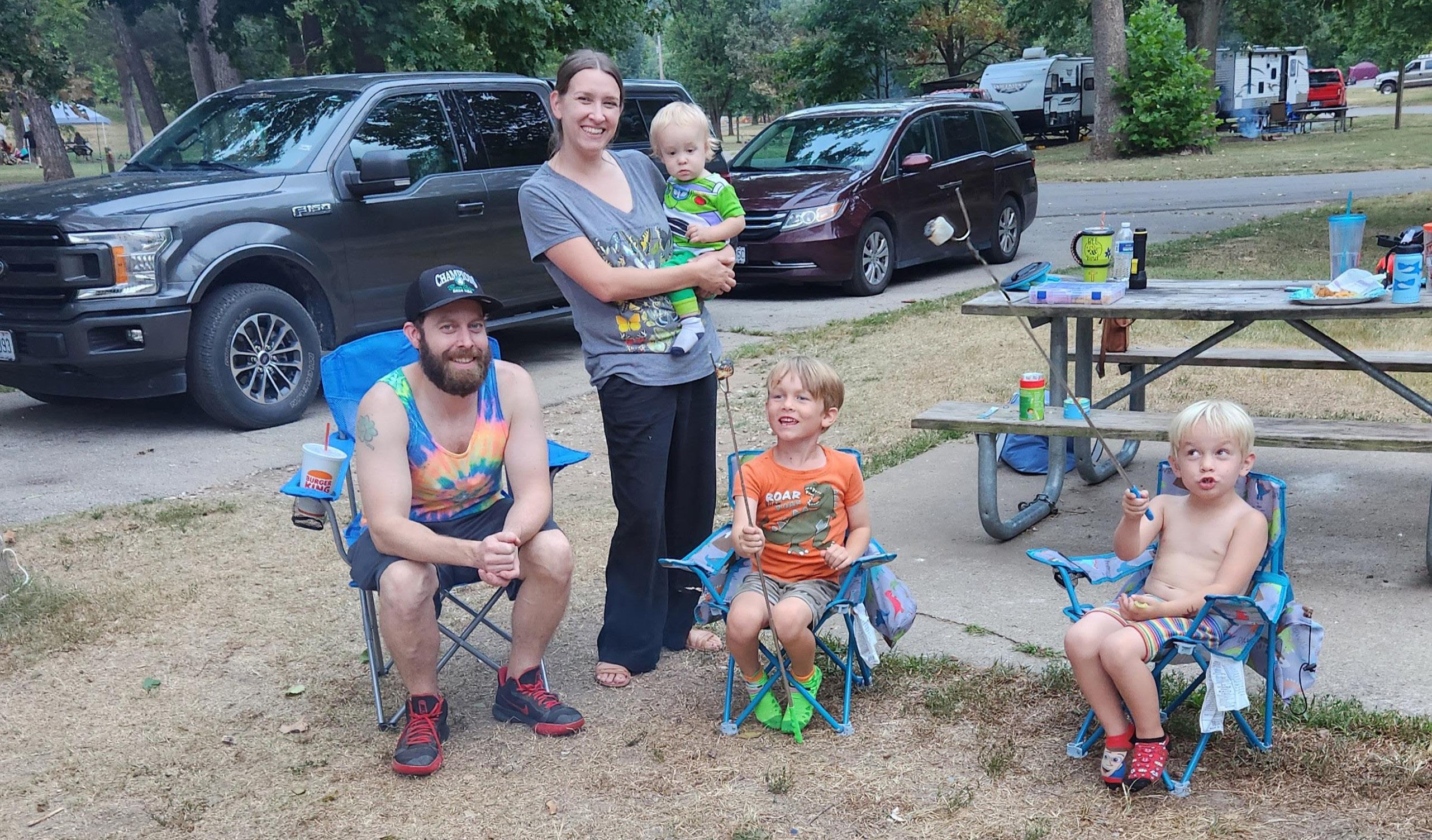
Next, it’s off to the campground store to do some souvenir shopping and to buy our daily trout tags for fishing. We all love the magical place called the camp store as its filled with brightly colored trout flies and lures, has snacks, candy, T-shirts, stuffed animals, and Ice Cream!
The rest of the day was filled with more of the same and we did try our luck at fishing. Dad Mark caught a couple of trout but the rest of us had no luck. We didn’t work at it very hard or for very long as there was always another rock to throw or path to explore. The evening was again about eating and a campfire with the addition of trying to catch a firefly.
Frank learned that running around tents in the dark can be hazardous, especially when the tent stake ropes from grandpa’s old canvas tent become hard to see and send you flying head over heels while trying to catch that firefly.
After breakfast and throwing a few more rocks the next morning it’s time to break down camp. It seems like chaos for the next hour, especially when you can see and hear a pop-up summertime thunderstorm rapidly approaching. We just barely get everything back into the truck and minivan when the storm hits. It’s pouring buckets as we stop at the campground store one last time for road trip goodies.
We all deemed the first family camping trip a success with the usual scrapes, bumps, bruises and a slight case of poison ivy for Frank. It’s a lot of work and it takes a whole team but the memories made, especially for the kids are priceless. You can find out more about camping at Roaring River as well as all of Missouri’s State Parks on this website mostateparks.com
Jeff Blystone (Photos: Jeff Blystone)




Summertime Tactics for Missouri Crappie

Missouri crappie readily bite for nearly everyone in the spring, but these panfish become more of a challenge to catch in the heat of summer.
When the summertime sun raises water temperatures above the 80-degree mark, crappie seek deeper water and heavier cover. The fish still remain active, though, as they feed on schools of shad passing through the crappie's hot-weather haunts.
On my home waters of Lake of the Ozarks, summertime crappie fishing poses two problems: heavy recreational boat traffic and a lack of visible cover. I solve the first problem by fishing early and late in the day to avoid the traffic. Crappie tend to burrow into the middle of brush when recreational boaters churn up the water and it becomes difficult to position my boat in the rolling waves and properly present my lure through the brush.
The second problem is solved by fishing around docks that have brush sunken next to the floating structure. Crappie can be taken from docks on either the main lake or even the backs of coves, as long as the piers sit close to deep water. The majority of bigger fish I catch come from brush piles 10 to 15 feet deep with 20-foot plus water nearby.
The fish vary in depth during the summer, coming up and going down depending on water temperature, storm fronts and boat traffic. The biggest trick to daytime crappie fishing in the summer is fishing down in the brush. Determining the lake’s thermocline will help you find the proper depth to fish throughout the summer.
I also catch crappie under the dock lights at night during the dog days of summer. The lights attract plankton which draw minnows and shad to the surface to feed on the microorganisms.
Crappie can be caught shallower during this time as they move up for a midnight snack of baitfish. The clear-water sections of a lake provide the best nighttime fishing.
Some fish can also be caught in the clear water early and late in the day, but mid-day action is slow as the crappie suspend over deep water. In the stained water areas of a lake the fish stay shallower and are easier to catch throughout the day.
Minnows are the most popular summertime bait for anglers fishing a tight line off docks or spider rigging in boats. Since a crappie's appetite is voracious during the summer, I select larger minnows (sometimes bigger than 3 inches) for my bait. I prefer using 2/0 and 3/0 hooks because the bigger hook is easier to remove from a crappie, and the fish don’t swallow it as much as they do a smaller hook.
Jigs are also productive for summertime crappie. I use either a single 1/16-ounce jig for shooting docks or a double rig for vertically jigging above brush piles. The double rig consists of a 1/16-ounce jig spaced 18 inches above a 1/8-ounce jig at the end of my line.
While my home lake lacks visible cover, Truman Lake is another one of my favorite summertime crappie fisheries that has plenty of it. Lots of standing timber was left in Truman when the Army Corps of Engineers filled the lake.
The lowland lake has more turbid water so crappie can be caught in both shallow and deep water in the summertime. A shallow-water pattern produces best when a summertime shad hatch occurs, but for most of the summer you need to fish deeper water.
The shallow pattern consists of dipping minnows with a long pole and slip-bobber system in timber along fence rows and tree lines on the main lake or creek channel. You can catch these fish less than 10 feet deep and sometimes even as shallow as 2 feet. The slip-bobber system allows you to adjust your bobber up or down to find the magic depth in which the crappie are holding. Use number 2 or 4 hooks and pinch on a couple of number 5 split shots about 2 to 3 inches above the hook. Keeping the weight close to the minnow will restrict its movement to prevent hang-ups in the heavy cover.
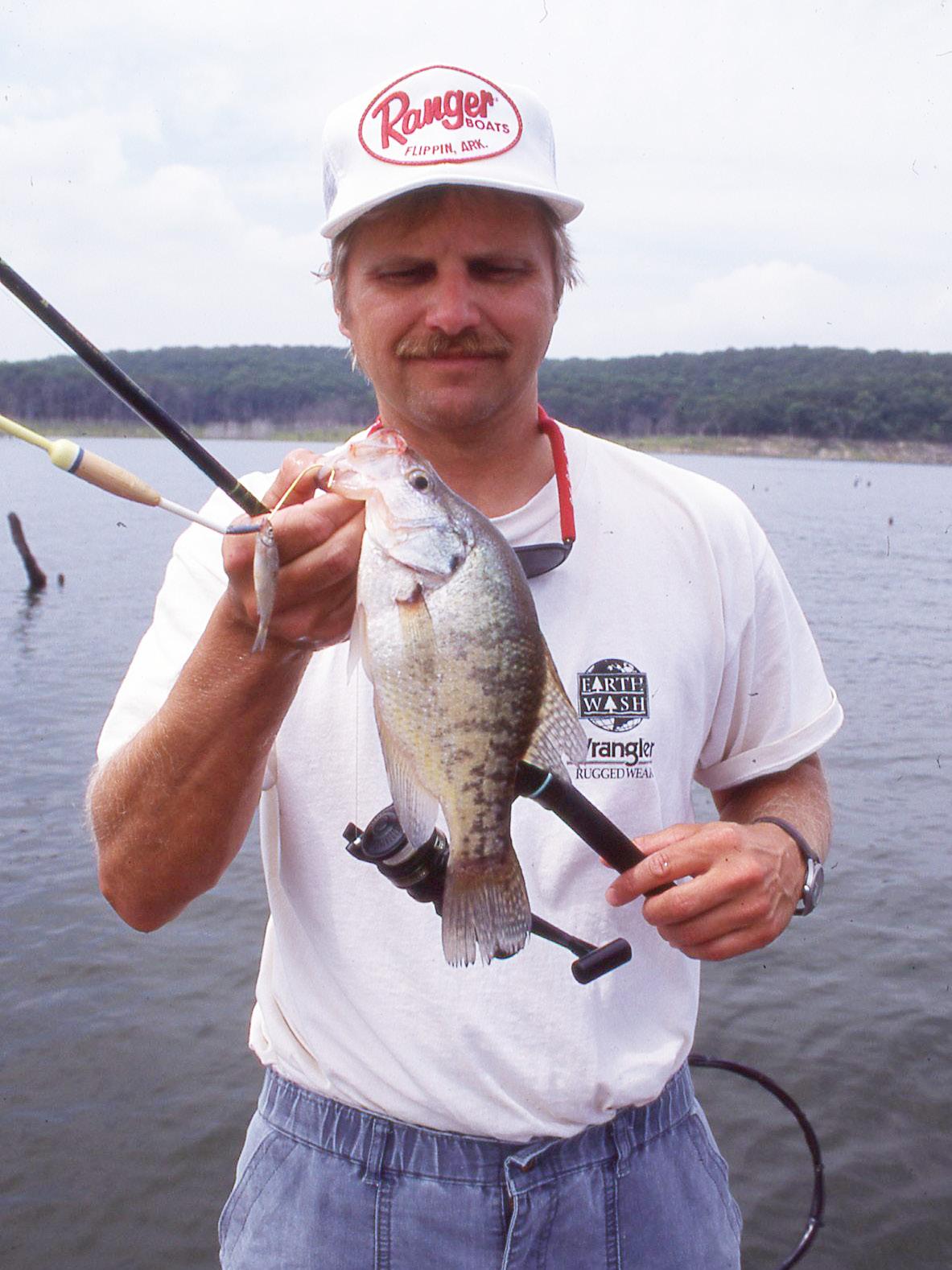
The deep-water pattern works best in timber along main lake bluffs and channel swings during the hottest part of summer. The fish will vary in depth from 15 to 25 feet depending on the lake’s thermocline. The same slipbobber rig used for catching shallow crappie also works in the deeper water because the fish will be suspended in the timber. If it’s too windy the bobber will bounce too much in the waves and make your presentation look unnatural. Remove the slip bobber rig then and present your minnow vertically on a tight line next to the timber to trigger a bite.
Try these patterns for crappie action as hot as the Missouri summertime weather.
Cover - Fishing around Truman Lake’s standing timber is a good tactic for catching crappie in the heat of summer.
Top - The author caught this summertime Truman Lake crappie with a minnow on a slip bobber rig. (Photos: Carol Neporadny)
John Neporadny Jr.

This story about seeds starts 30,000 years ago with a squirrel. Or rather, a few dozen generations of squirrels that stuffed their burrows with seeds for winter. They didn’t survive to eat them, and the seeds didn’t sprout. Permafrost took over and locked them away for ages.
Buried Treasure
In the early 2000s, Russian scientists found those seeds in northeastern Siberia. The mature seeds were damaged, but they were able to extract living tissue from immature seeds. The plant that emerged, Silene stenophylla, is a pretty, unassuming wildflower. It’s still around today, only slightly altered from the ancient generation. But it’s living proof of what seeds can do: wait, adapt, and outlast us all.
Back to the Seed: Where the Story Begins
My husband and I saw that resilience in action a few years ago when we worked with the MDC to turn some of our property into native habitat. Most of it was fescue pasture when we moved in, and there was no way we wanted to spend our time mowing it. Our first task was to kill the fescue, and we were astounded by the variety and vitality of the seeds that had been patiently waiting for that to happen. We have natives growing now, but there are still plants out there that have sprung to life from seeds long buried in the soil.
And that brings us to the topic of this short series: seed conservation. It’s not only about rare species or doomsday vaults in the Arctic. It’s about resilience. It’s about options. It’s about keeping the wild card in the deck.
Why Seeds Matter
Seeds hold the DNA of adaptation. They’re the reason we still have prairie smoke, prairie dock and prairie blazing star. When native habitats get plowed under, paved over, or swallowed up by invasive species, seeds are often the only path back. They’re also how we maintain genetic diversity within a species. That makes everythingplants, animals, and entire ecosystems - more resilient to disease, drought, pests, and climate shifts.
In Missouri, that resilience is under pressure. More than 90% of our original tallgrass prairie is gone and not coming back. Pollinators are declining. So are groundnesting birds, frogs, toads, and a long list of beneficial insects that rely on native plants to complete their life cycles.
If we want to turn the tide, or at least stay the course, we need seeds. The right seeds. Locally adapted, genetically diverse, well-stewarded seeds.
It’s Not as Simple as It Sounds
Here’s where things get tricky. You can’t shake a packet of wildflower mix onto the ground and call it conservation. I’ve done that before and have come to regret it. Commercial seed mixes often focus on color and bloom time over ecological value. Some include nonnative species or invasive ones.
Real seed conservation means knowing your ecoregion. It means sourcing seed from reputable growers who collect and maintain the genetic integrity of wild populations. When we planted our fields, the MDC asked for proof from the seller showing which county in Missouri each seed came from.
What’s Being Done
There’s lots of good news here. Missouri is home to some of the best native seed operations in the country. The Missouri Prairie Foundation’s Grow Native! is an incredible program that connects landowners to highquality seed and native plant resources.
Shaw Nature Reserve in Gray Summit houses a native seed bank focused on preserving the genetic diversity of prairie plants found throughout the state. Shaw has long been a leader in ecological restoration. Their seed bank collects and stores native species as an insurance policy against loss and a source for rebuilding resilient habitats.
Meanwhile, volunteers across the state are harvesting wild seed by hand, one pod at a time, to support prairie restorations like mine on public and private land. The work is meticulous - I’ve watched volunteers cleaning seed by hand, and it’s not something I’d willingly sign up to do.
Where This Series Is Headed
In the next installments, we’ll dive into how seed conservation works, both globally and right here in Missouri. We’ll look at seed banks, seed swaps, remnant prairies, and backyard efforts like mine. You’ll meet the people who save seeds for a living, and the ones who just do it because they love it.
Maybe you’ll also want to be part of the action. Anyone can take part, whether you’re managing 400 acres or planting a single milkweed in a suburban flowerbed.
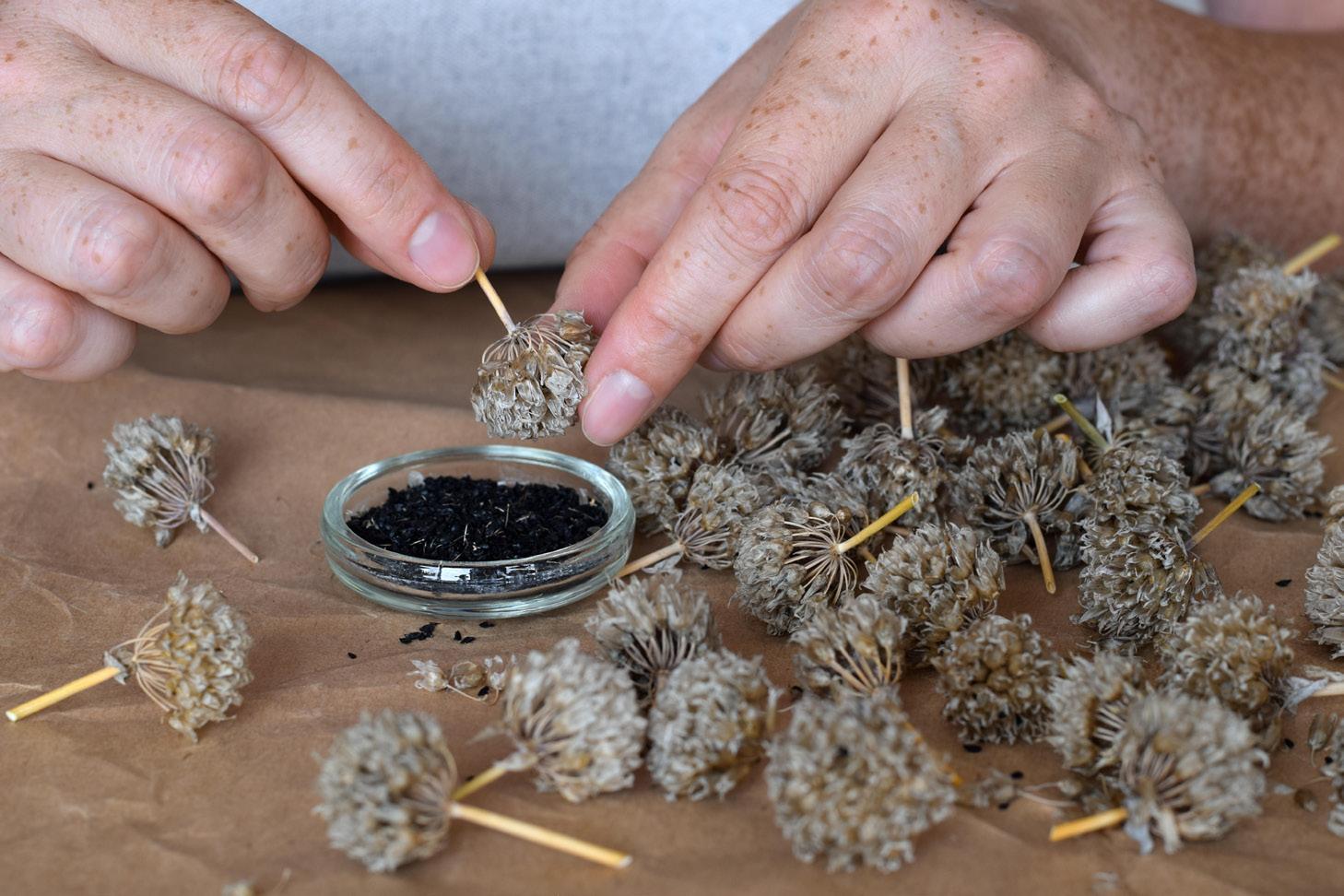
So, next time you pull weeds or deadhead a spent bloom, stop for a second. Look at the seed in your hand. Somewhere in that tiny bundle of carbon and code is a memory of fire, flood, wind, frost, and bees. A whole lineage waiting to continue—if we let it.
Dr. Jane Williams
Cover - A plant regenerated from 32,000-year-old seeds. (Photo: Courtesy of the National Academy of Sciences) Left - Hands cleaning seeds. (Photo: Stock)
Turning Off the Plastic Tap: How Local Advocacy Can Drive Big Change
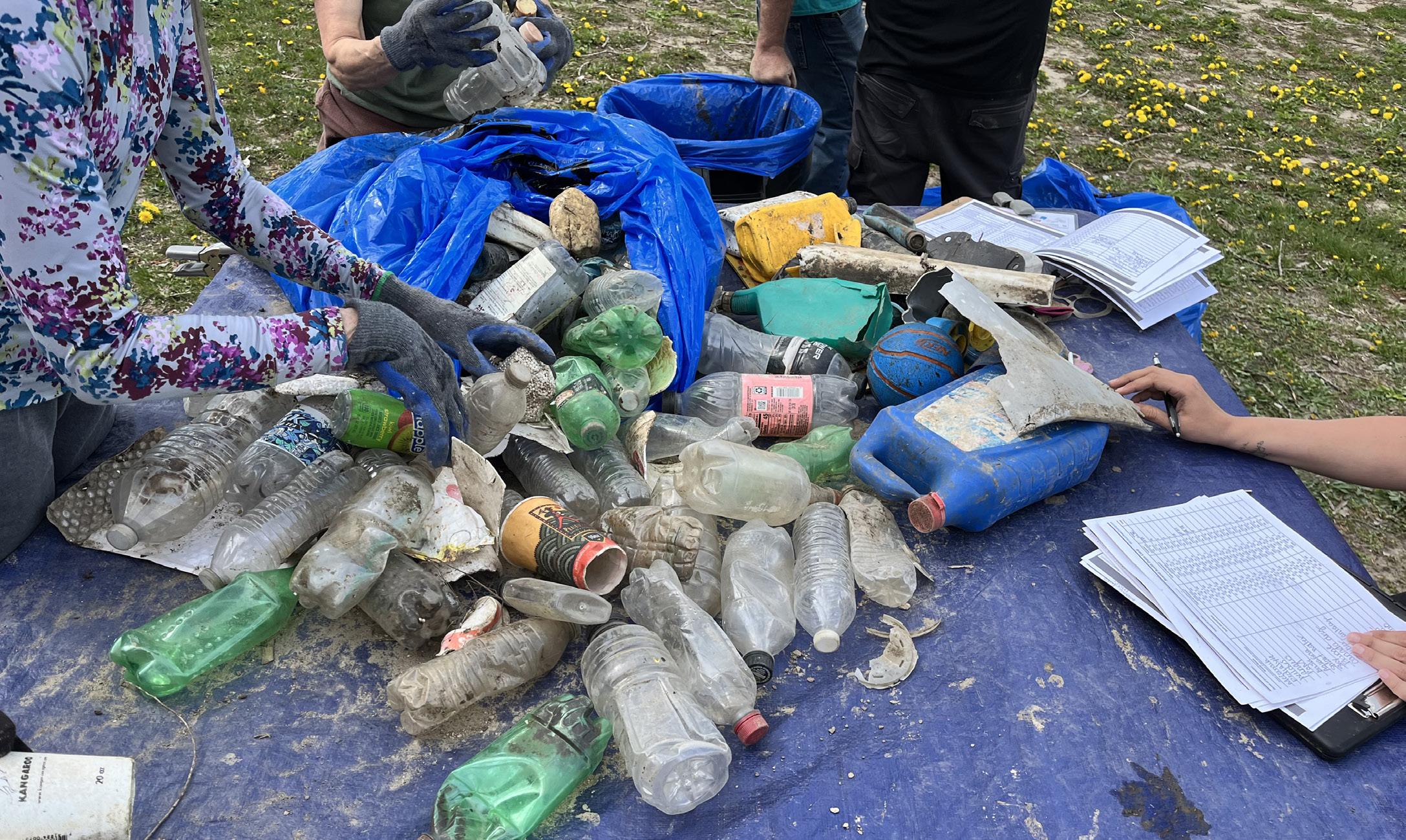
Plastics have infiltrated nearly every corner of our lives. From the packaging on our groceries to the fibers in our clothes, from children’s toys to electronic devices, plastic has become an inescapable part of modern living. But behind the convenience lies a growing environmental and health crisis. Plastics are made from carbon-based fossil fuels and chemicals— many of them untested or harmful—and their overproduction is fueling pollution that now reaches from the deepest ocean trenches to the most remote mountaintops. In addition, plastic production generates massive amounts of greenhouse gas emissions, driving climate change alongside other fossil fuel sectors.
To understand how we arrived at this crisis, we need to look back. Plastic began its rise in the late 1800s and early 1900s with early innovations like rubber and electrical insulators. But it was World War II that catapulted plastics into mass production, as the military’s need for nylon parachutes, rain gear, and protective wrappings revealed the material’s potential. After the war, petrochemical companies saw opportunity: by the 1950s, plastics were pouring into homes as disposable consumer goods. Since 1950, global plastic production has tripled and is expected to triple again by 2060. Astonishingly, 56% of all plastics ever made have been produced since the year 2000. In the U.S., annual plastic waste per person has skyrocketed from about 2 pounds in 1950 to more than 280 pounds today.
The scale of this production has overwhelmed our ability to manage the waste. According to the Organisation for Economic Co-operation and Development, only about 9% of plastic ever produced has been recycled, 19% has been incinerated, and a staggering 72% has ended up in landfills or scattered across the environment. Contrary to popular belief, most plastic in the environment is not simply the result of careless littering—it’s the inevitable outcome of a system producing more plastic than any waste management system can realistically handle. Plastics break down not into harmless substances, but into microplastics and nanoplastics—tiny particles that persist in ecosystems, wildlife, and even human bodies.
Bird populations are among the most visible victims. Birds often mistake plastic debris such as bottle caps and food wrappers for food, leading to malnutrition, digestive blockages, and internal injuries. Plastics in nests can harm eggs and chicks, and brightly colored plastic can attract predators. Perhaps most disturbingly, researchers have documented a new disease called “plasticosis” in seabirds, caused by microplastics embedding into their stomach tissue, causing chronic inflammation and scarring that impairs digestion and survival.
The impacts go well beyond wildlife. Many plastics contain toxic substances like PFAS, phthalates, and BPA, which can leach into soil, water, and food chains, ultimately posing risks to human health. Burning plastic doesn’t solve the problem—it simply releases dangerous pollutants like dioxins into the air, contributing to climate change and public health hazards. In fact, from production to disposal, plastics are a significant and growing source of greenhouse gas emissions, making the problem not just an issue of waste but a direct driver of the climate emergency. Today, the fossil fuel and petrochemical industries are doubling down on plastics as a way to sustain demand for oil and gas, even as the world shifts away from fossil fuels for energy.
Despite years of promoting recycling as the solution, the reality is clear: we cannot recycle our way out of the plastic crisis. The only effective path forward is to “turn off the tap” of plastic production. This means addressing the problem at its source—through local, state, and national policy changes that limit plastic production and hold the fossil fuel and petrochemical industries accountable.
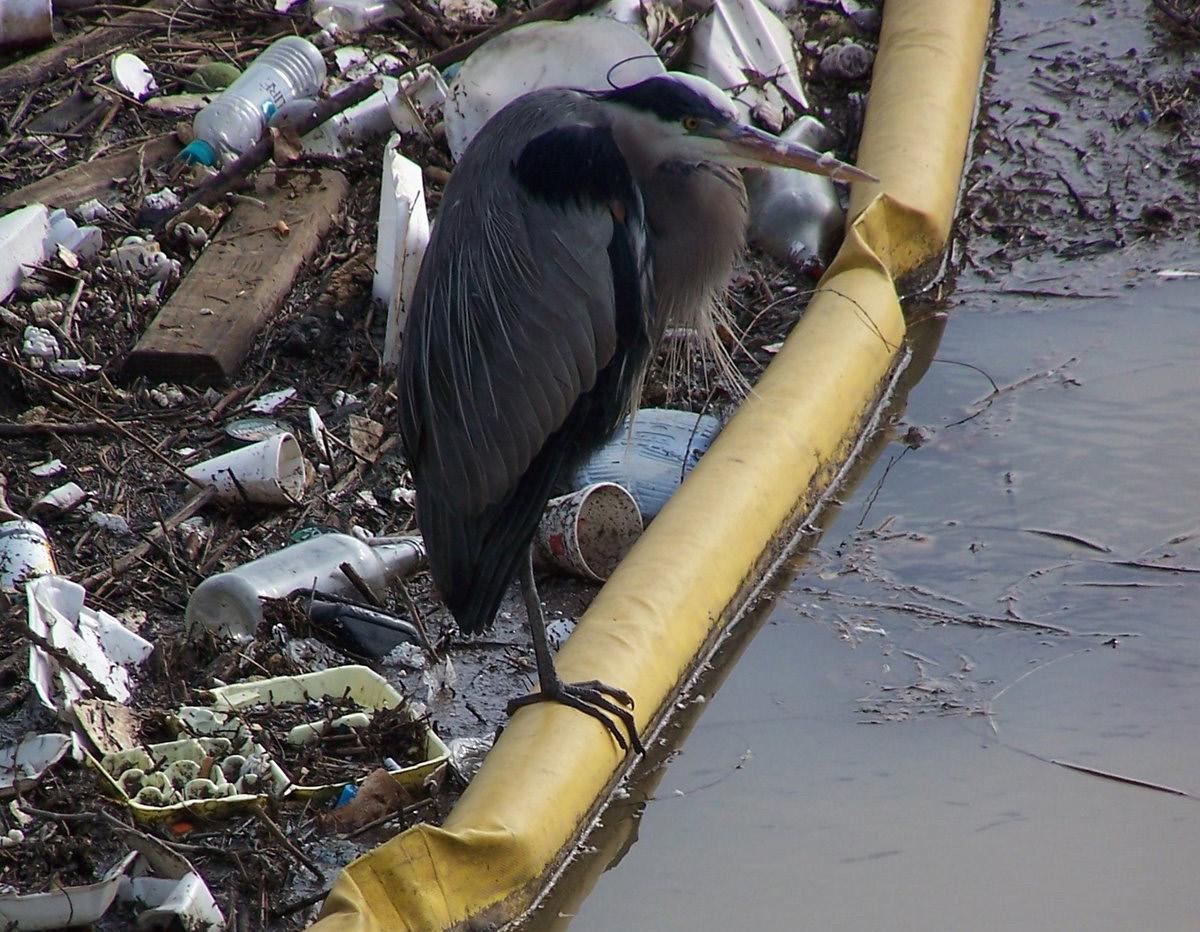
Across the U.S., we are already seeing encouraging signs of local and state action. Twelve states have implemented bans on single-use plastic bags, demonstrating that policy can drive meaningful change. Missouri is seeing momentum through efforts like the Show-Me Less Plastic project, organized by Missouri River Bird Observatory and Stream Teams United. This initiative empowers a network of educators and advocates to push for state-level change and raise public awareness about plastic’s impacts.
Advocating for strong policy measures at the local and state levels is one of the most powerful tools available to citizens today. Here’s how individuals and communities can help drive systemic change:
• Support and advocate for plastic reduction legislation: Policies that limit single-use plastics, ban problematic products like plastic bags and straws, improve recycling infrastructure, and set producer responsibility standards are essential. Contact your state legislators, testify at public hearings, sign petitions, and join advocacy campaigns demanding action.
• Push for corporate accountability: Corporations are major drivers of plastic pollution through excessive packaging and disposable products. Advocate for extended producer responsibility (EPR) laws that require companies to take responsibility for the full life cycle of their products. Participate in brand audits in your community to document the worst corporate offenders and share that information with policymakers and the media.
Right - A Great Blue Heron lives amidst plastic trash in the greenway of Knoxville, TN. (Photo: Ethan Duke)
• Promote and support local ordinances: Even in the absence of state or federal action, cities and counties can adopt ordinances to ban or restrict plastics, require compostable alternatives, and improve waste collection. Grassroots pressure can often succeed where national lobbying falls short.
• Champion innovation and alternatives: Encourage public investment and incentives for companies developing sustainable materials and packaging. Advocate for state-funded research programs or tax breaks for businesses using biodegradable or reusable alternatives.
• Engage your community: Educating neighbors, schools, and local organizations about the plastic crisis helps build a collective voice for policy change. Organize or join local cleanups not just to remove waste, but to collect data that can be used to advocate for stronger regulations. Educational workshops, film screenings, and town hall meetings can also raise awareness and mobilize action.
While individual lifestyle changes like using reusable bags, bottles, and containers have value, they are not enough to solve the plastic crisis on their own. Structural problems demand structural solutions, and that means focusing energy on advocacy and policy change.
The scale of the challenge can feel overwhelming, but the good news is that many communities and states are already proving that change is possible. By working together—across neighborhoods, cities, and states—we can reshape our systems, reduce our reliance on plastics, and protect the health of our ecosystems, wildlife, and ourselves.
The plastic pollution crisis is not inevitable. It’s the result of decades of unchecked industry expansion, including the petrochemical industry’s push to maintain fossil fuel demand through plastic production. But with determined advocacy, smart policy, and collective action, we can change course. It’s time to shift the burden of responsibility from individuals to the industries and systems that have profited from plastic’s proliferation.
Missouri River Bird Observatory & Missouri Stream Teams United
Cover - Collecting data on plastic trash pulled out of the Missouri River at Sugar Creek by Missouri River Relief, April 2025. Brand audits compile data on who contributes the most waste. See brandaudit.breakfreefromplastic.org for more information. (Photos: Dana Ripper)
Take Action on the Plastic Crisis!
Plastic pollution is overwhelming our planet—but you can help drive systemic change in your own community and state.
Support policy solutions
Call or email your state representatives to back bans on single-use plastics and stronger recycling laws.
Hold corporations accountable:
Participate in brand audits and demand companies reduce unnecessary plastic packaging.
Push local action:
Advocate for city or county ordinances to limit plastic use and promote compostable alternatives.
Join local networks:
Get involved with initiatives like Missouri’s Show-Me Less Plastic project to help build a coordinated voice for change.
Raise awareness:
Organize educational events, share facts with your community, and collect data during local cleanups to push for better policies.
We don’t just need individual change—we need system change. Let’s work together to turn off the plastic tap!
Proposed Changes to Endangered Species Act Regulations Would Harm Species Recovery
CFM recently submitted comments to the federal regulatory docket to oppose proposed changes that would rescind the definition of “harm” from Endangered Species Act (ESA) regulations. This action would remove language that protects against harmful habitat modification or degradation that negatively affect threatened or endangered species.
Most of the efforts taken by regulatory agencies under the ESA focus on measures to protect, enhance, or restore habitat. These actions are taken in accordance with the definition of preventing “harm” of a listed species are necessary to prevent the resulting “take” of a species through habitat destruction or degradation. The role of habitat in species survival cannot be overstated. A habitat, by definition, provides all the resources an organism needs to survive. Consequently, if you take away or degrade an organism’s habitat, it is clearly threatening the survival of the organism in question.
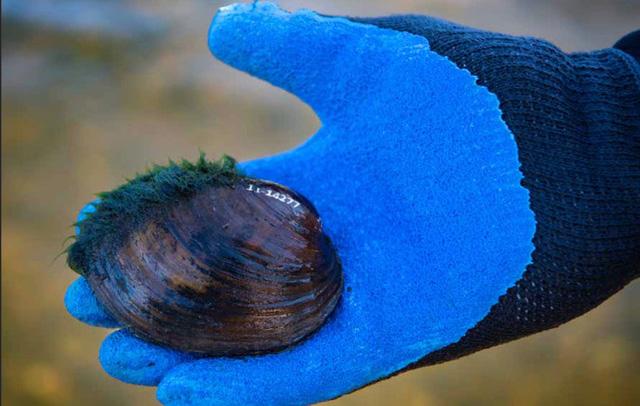
The results were striking: not a single project was halted or extensively altered due to a FWS finding of jeopardy to a species or destruction/adverse modification of critical habitat. In addition, the ESA provides flexibility for businesses, allowing for the issuance of permits for "incidental take" when actions to avoid or minimize harm are not feasible.
The ESA is widely recognized as one of the world’s premier conservation laws and its protections are critical for the continued survival of imperiled species and the ecosystems upon which they depend. At the heart of the ESA is the Public Trust Doctrine, which holds that natural resources are held in trust by a sovereign, in this case the federal government, for the benefit of the public. This doctrine imposes a duty to protect these resources for all citizens, not just private individuals.
Some have raised concerns about the economic impacts of the ESA. However, in practice, most projects evaluated under the ESA do not result in the cessation of development. Instead, they involve project modifications or mitigation efforts to reduce impacts on endangered species and their habitats. A study published in the Proceedings of the National Academy of Sciences analyzed all 88,290 consultations conducted by the FWS from January 2008 through April 2015.
In the broader sense, the provisions in the ESA that prevent harm to habitat or require habitat mitigation are a net benefit to businesses and the economy. The hunting, fishing, and outdoor recreation industries add billions of dollars to local, state, and national economies. A variety of studies indicate that investment in protecting and restoring habitat has positive economic benefits. For example, one study found that for every $1 million dollars spent on habitat restoration, $2.2 to $3.4 million dollars of direct and indirect economic benefits accrued to service businesses and contractors.
The ESA has been a cornerstone of American conservation efforts for over 50 years, and it remains essential to ensuring the survival of our nation’s wildlife. Protecting habitat is not only a moral and legal obligation; it is also an economic imperative that benefits communities across the country.
Leanne Tippett Mosby

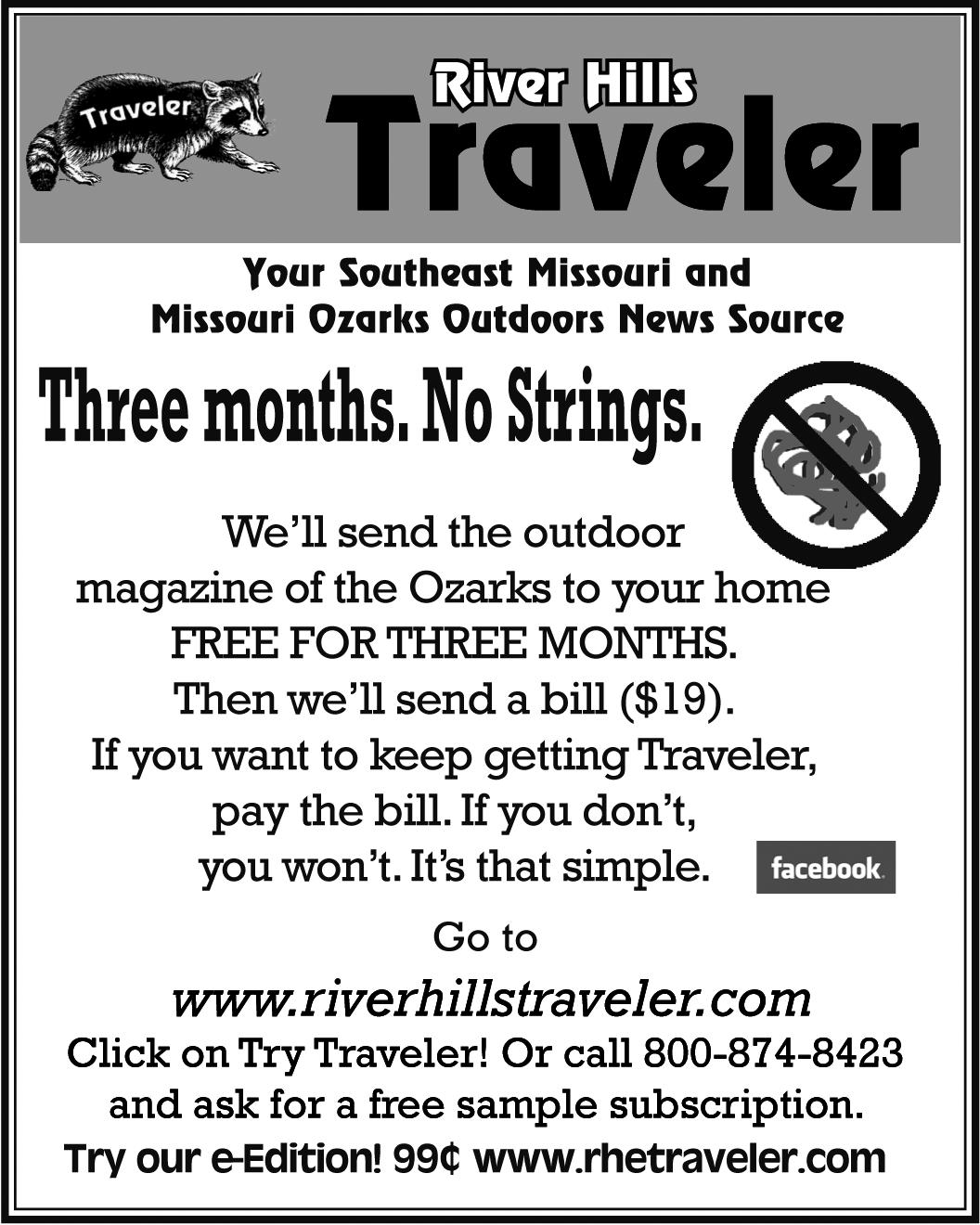








Panfish Are King
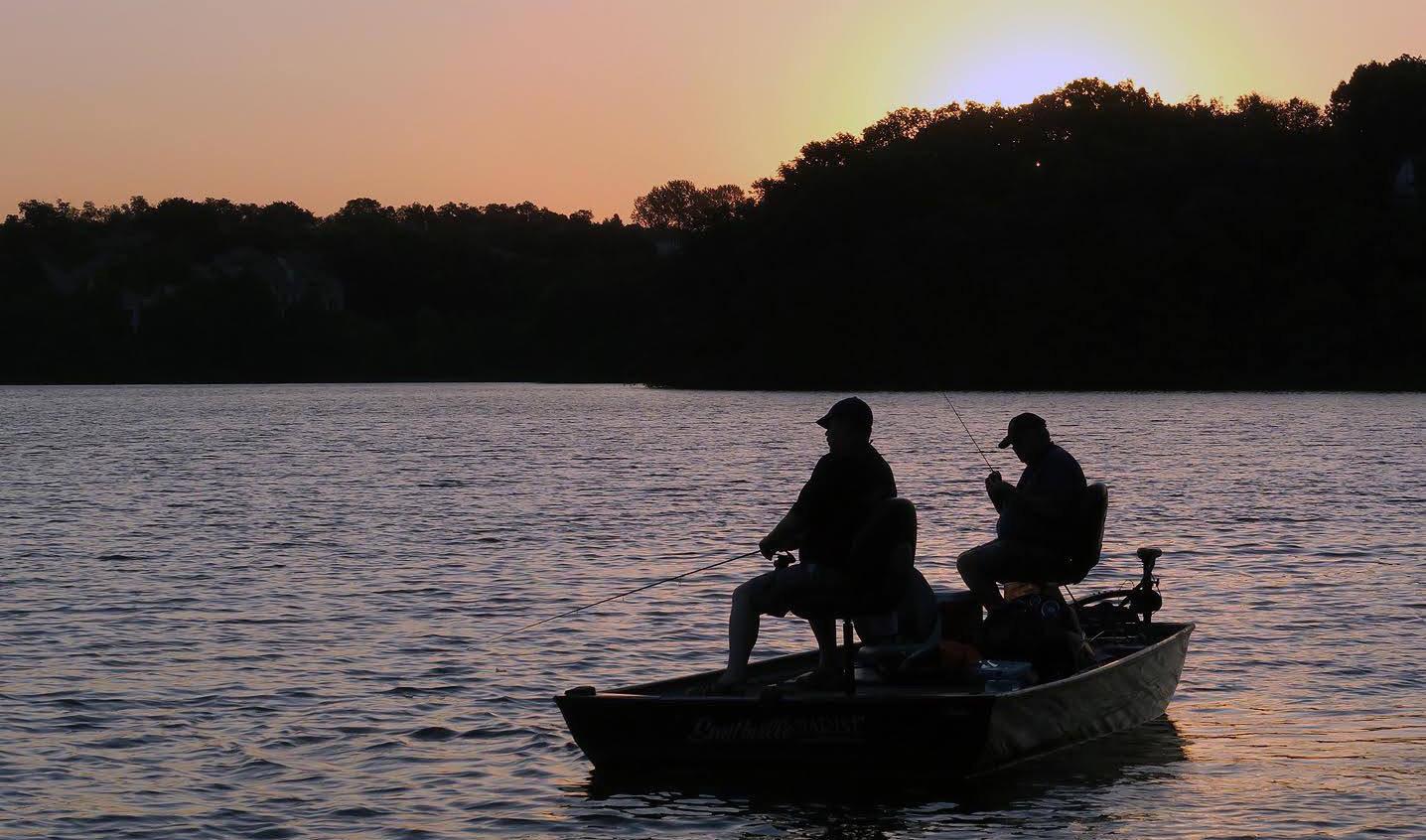
Early summer offers perfect conditions for catching big bluegill or redear sunfish. Few fish their size fight better and a skillet of their fillets quickly disappear, especially with a generous helping of fried potatoes or a pot of brown beans. Match your equipment to this fish and you will enjoy some vicious fights.
The late Bill Bennett, veteran outdoor editor from the St. Joseph News Press and one of my teachers in outdoor writing, helped me fit into this highly competitive profession. I had great respect for Mr. Bennett’s writing and was honored to be invited on a fishing trip to Pony Express Lake in Northwest, Missouri.
I was somewhat surprised when he told me over the phone to bring a lightweight flyrod with a tippet no larger than two pounds. On arrival he handed me a black gnat fly he had tied the night before. We loaded up in his canoe and quickly slipped towards a half-submerged log not far off the shoreline. We quietly dropped small anchors. Bennett stressed the importance of always keeping our line tight--especially on the drop. I soon found out why.
His first presentation placed the gnat almost directly on submerged wood. He gave a very gentle twitch and a redear took the gnat, barely twitching the rod, and dove towards the bottom. I sat back and watched the fight. The good sized panfish doubled his light flyrod and made long, slashing runs. I netted the beautiful fish that was slightly over a pound and soon released.
“Let’s come back to this log later,” Bennett said while flashing his signature smile. “That was a good fight and others probably spooked off the log, but they will be back. We spent that morning picking redears off submerged wood. Occasionally a big bluegill took the black gnats.
There were plenty of logs in the lake and we caught and released redear sunfish the entire morning. Bennett’s tactic of laying the gnat on each log or between limbs drew a strike almost every time, including a couple of nice bass and two baskets of big bluegill.
That was my last trip with Mr. Bennett. He passed away a few weeks later in his favorite chair while watching television with his wife. I hope his legacy has partly stayed alive though my articles and books. He not only helped me get started, but now I have a lifelong passion for using light fly tackle for panfish like redears and big bluegill.
Flyfishing For Bluegill: Popping bug or rubber spider colors for bluegill are not hard to choose. An old fisherman once told me, “It does not matter what color you use, long as its yellow.”
This is good advice, but black, brown, and white will attract a fair share of bites too. Popping bugs, worms, crickets, and tiny lures are the main bluegill baits with an 8-inch leader of two-to-four-pound test.
Bluegill move into the shallows for food throughout spring. Anglers have a lot of success around logs and stumps before and after the spawn. Wood draws a healthy population of insects, excellent forage making black and brown wet flies effective.
Flip the tiny popper in productive water and gently move the rod tip until the rubber legs kick. All game fish love to find a bug struggling and helpless in the water imitating an easy meal. Be cautious not to make a lot of noise and spook bigger bluegill out of the area.
Redear: Bluegill’s cousin, redear sunfish, are commonly called shell crackers in the southern United States because they dine on snails. They sometimes are confused with bluegill, but differ by having a red or orange border around the black ear flap and by lacking the spot on the dorsal fin and the vertical bars on the side. Redear grow larger than bluegill, sometimes up to 11 inches.
In fact, two-pound fish are not uncommon in southern regions where they have a longer feeding season. This hearty panfish is stocked as far north as Iowa in selected lakes. Check with your fish and game commission to find out where redear are stocked in your state.
Redear are often found on deeper outside edges of bluegill beds. Bluegill are usually finished with their first spawn by the end of May. Pockmarked bluegill beds are easily visible in shallow water and are good areas to target.
Breeding season that starts in early May and runs through June is probably the best time to catch redear. Redear keep a small distance from other panfish breeding areas to discourage crossing species
Redear are not impossible to catch, but more challenging than a bluegill. Bits of live worm, euro lave or crickets will work. Live bait should be presented on a tiny gold or black hook. Feathered 1/100-ounce jigs or small flies work well.
Wet flies are preferred, but a redear will occasionally pop a topwater insect. Black or dark brown lures are mainly used. Try small gnats, weighted nymphs, soft hackles, and streamers. These patterns effectively mimic the natural food of redears, such as aquatic insects and larvae, which they feed on near the bottom. Visit a flyfishing shop and they will likely have a thousand other recommendations on what flies to use for redear.
Redear will spook out of an area quicker than any other game fish and require a quiet approach from the shore or boat. Many use a float tube. I prefer a canoe or small, two-man boat. Smaller craft allow you to move in closer. A bigger boat requires long distance casting.
Note: Many anglers practice catch and release for redears. But in some area’s fishery biologists encourage harvesting this large panfish to discourage over populating and stunting. Check your local regulations for more information or redears availability.
This column is dedicated to the late Bill Bennett, my mentor in writing and a good friend. I hope the old master approves of my work!
Photo: Jeannie Pyland
Kenneth L. Kieser

Fostering Bird-friendly Communities
North American bird populations have been facing exponential declines since the 1970s. These declines are driven by anthropogenic factors including habitat loss, light pollution, window collisions, plastic pollution, pesticides and other environmental toxins. As urbanization continues to increase and expand, the need for bird-friendly communities has never been more urgent.
Urban areas pose significant threats to bird populations due to high concentration of human infrastructure and activities, which disrupt birds’ natural habitats and behaviors and compromise their overall health. However, this also means that urban areas can offer unique opportunities to change and provide a safe space for birds. Cities and communities can play a critical role in bird conservation by reducing threats and enhancing habitats.
Program designations including the Urban Bird Treaty and Bird City have a powerful role in leading communities to take action. These initiatives not only inspire individual efforts but also help create safer, more sustainable environments for both people and birds.
What is a Bird-friendly Community?
Bird-friendly Communities are cities, towns, and villages that actively work to reduce hazards for birds and create an environment where they can safely migrate through, nest, and live with access to reliable food sources. By addressing specific threats such as habitat loss, predation by cats, window collisions, pesticide use, and light pollution, these communities create a crucial safe haven.
These communities prioritize and emphasize green spaces, native plantings, public engagement, policies that promote bird conservation, and quality-oflife enhancement for both humans and wildlife. By incorporating bird-friendly designs in urban planning strategies such as bird safe windows, reducing artificial lighting, and planting native plants, cities can offer critical food sources and shelter for birds. Raising awareness and engaging the community in bird conservation efforts lead to more sustainable practices that help mitigate the adverse effects of urbanization on bird populations.
Programs
Urban Bird Treaty Program
The U.S. Fish and Wildlife Service launched this program in 1999. This program works to support cities to conserve migratory birds through collaborative partnerships. The goals for this program include:
• Protect, restore, and enhance urban habitats
• Reducing urban hazards to birds
• Engage urban communities in caring about and conserving birds and their habitats
More information about the Urban Bird Treaty: www.fws. gov/program/urban-bird-treaty
Bird City Network Program
Sister program to the Urban Bird Treaty and launched in 2009, this program designation recognizes municipalities and communities that are committed to protect birds and their habitats. Cities, towns, and campuses can apply for Bird City status by raising awareness and actively achieving specific bird-friendly actions. This program focuses on:
• Improving habitats
• Addressing threats
• Engaging people
• Promoting sustainability
More information about Bird City: www.birdcity.org/ missouri
How make your life and household more bird-friendly:
1. Make windows safer.
Birds don’t see glass the way we see glass. They don’t have the ability to distinguish reflections and mistake the reflections of vegetation or sky as an open space to fly to, which lead to fatal collisions. To prevent window collisions, treat your windows with dot-patterned film, zen curtains, or other methods.
2. Keep cats indoors.
Cats are one of the leading contributors to population declines. While hunting is instinctual, domestic cats are not native to North America and our wildlife did not evolve with this predator. Keeping cats indoors not only protects birds and other small animals, but also protects their health and longevity of your pet.
3. Plant native plants.
Planting native plants provides critical shelter, nesting sites, and food sources for birds and pollinators, especially during the migration season. Incorporating native plants into your gardens or community spaces helps sustain local ecosystems.
4. Avoid pesticides.
Pesticides and herbicides can directly harm birds or eliminate their food sources. Opting for organic, integrated pest management (IPM), or natural alternatives, we can create a healthier environment for wildlife and birds.
5. Drink bird-friendly coffee.
As coffee has gotten more popular over the past few decades, mass coffee producers rely on sun-grown methods, which is a process that involves clearcutting and deforestation. Meanwhile, shade-grown coffee is cultivated under a multi-layered canopy. This promotes biodiversity and provides crucial habitat for our migrating songbirds. The resulting brew is also less acidic on our bodies, has a bolder taste than sun-grown coffee, and is overall better for the birds and us.
6. Avoid plastic use.
Plastics are extremely harmful to birds, especially through ingestion and entanglement. Birds mistake plastic for food, which is often fatal. Plastics persist in the environment, which then accumulates exponentially in the environment, polluting our ecosystems, and harming wildlife. Reducing our reliance on single-use plastics can help protect our birds.
7. Citizen science.
Participating in monitoring projects, reporting bird sightings, or becoming involved in bird counts are all ways to contribute to citizen science. This helps support scientific research and conservation efforts. Raising awareness about the importance of bird conservation in local communities goes a long way.
For more information about bird declines check out: www.3billionbirds.org

Although creating a bird-friendly community may seem like a complex and large-scale endeavor, individual actions are also impactful. As bird populations continue to decline due to increasing environmental hazards, every effort, small or large, contributes meaningfully to conservation. Bird conservation is a collaborative initiative. By making informed choices and fostering awareness, we can collectively reshape and build safer, healthier environments for birds and in turn, enhance the ecological well-being of our communities.
The Path Forward
Kaylee Woelfel, MRBO Bird Friendly Communities Coordinator
Cover - Looking for Pilot Cities for Bird City Missouri (Photo: Missouri Bird-friendly Steering Committee, Artist: Adrienne Luther) Right - Cornell Lab of Ornithology





3
3
3
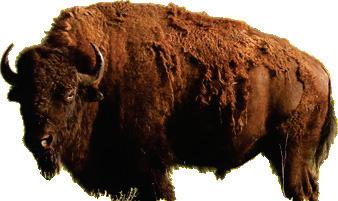







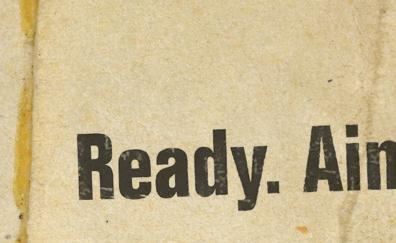

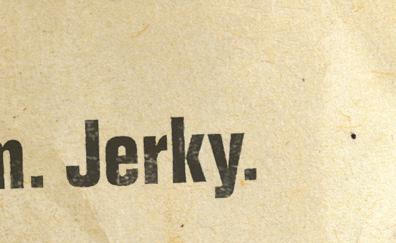






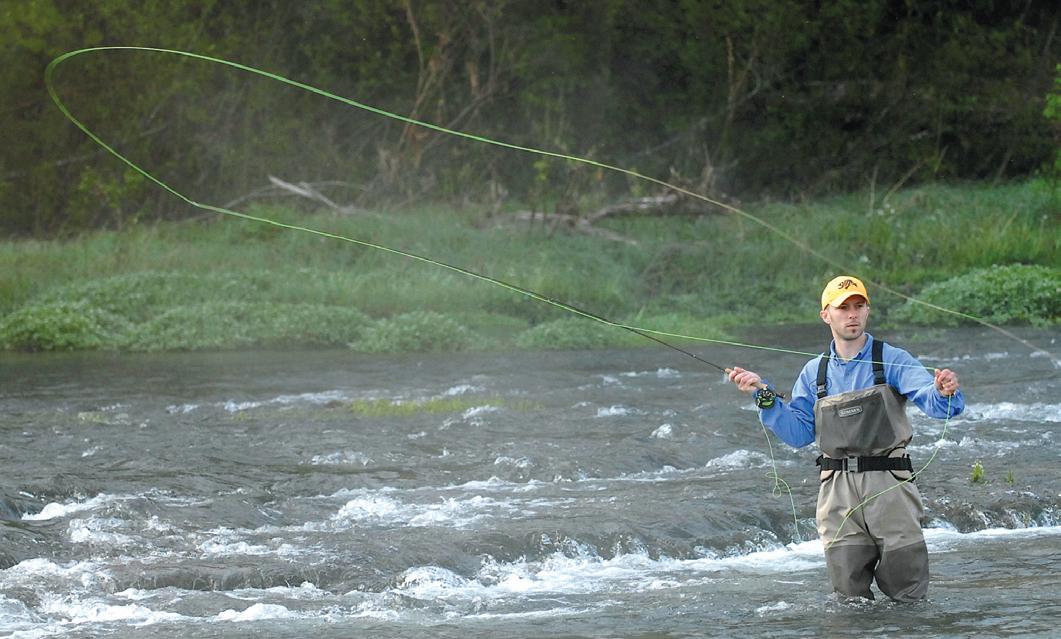
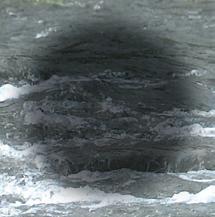










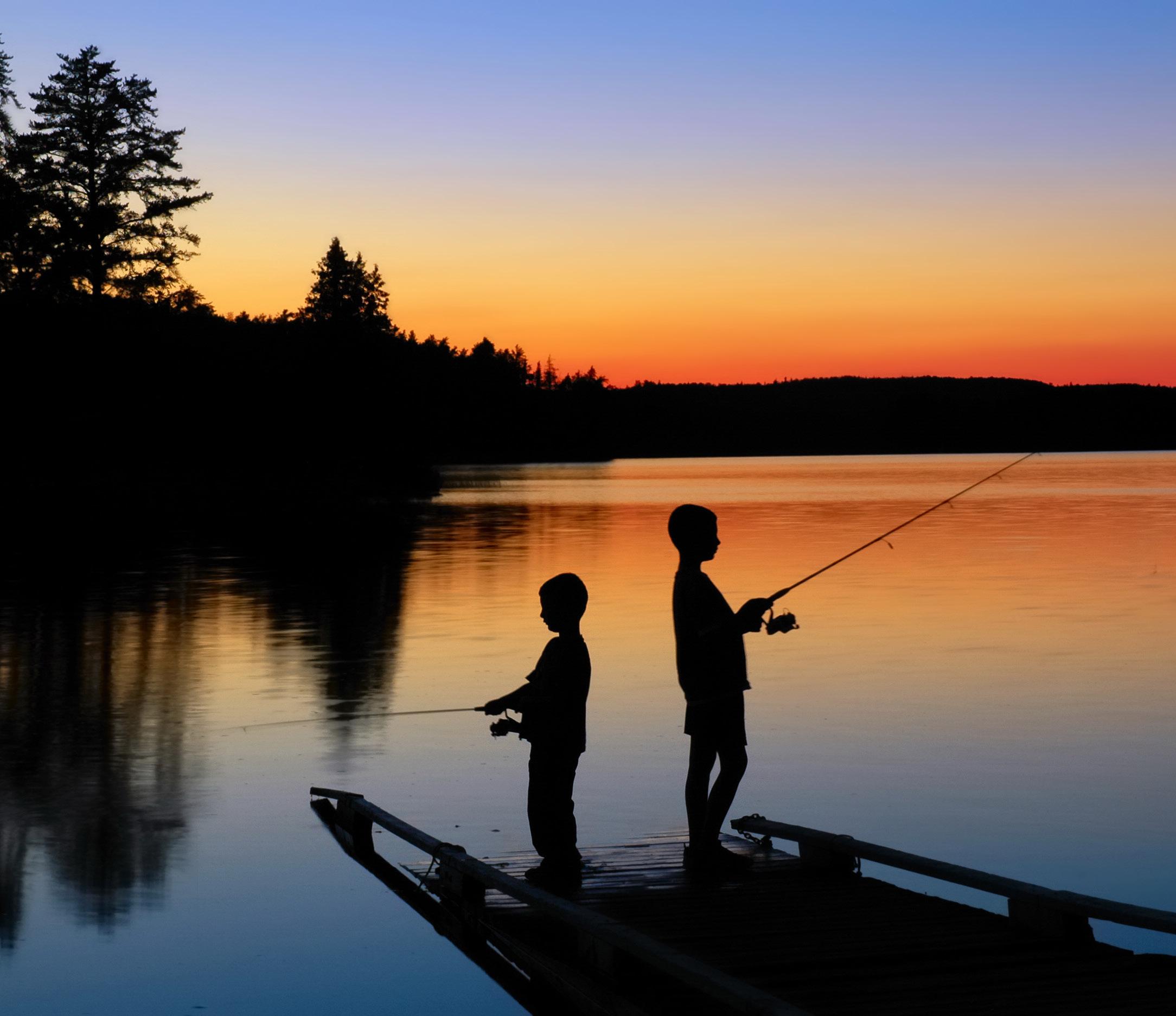
Include the Conservation Federation of Missouri in your estate plans.
Leave a legacy for the natural resources and traditions you have valued throughout your life. Make CFM a beneficiary of your will, trust, life insurance policy, or retirement plan. Any amount helps preserve Missouri’s resources and natural history for generations to come. What will your legacy be? Call 573-634-2322 to find out more information.

HOOK IT UP & GO HUNT
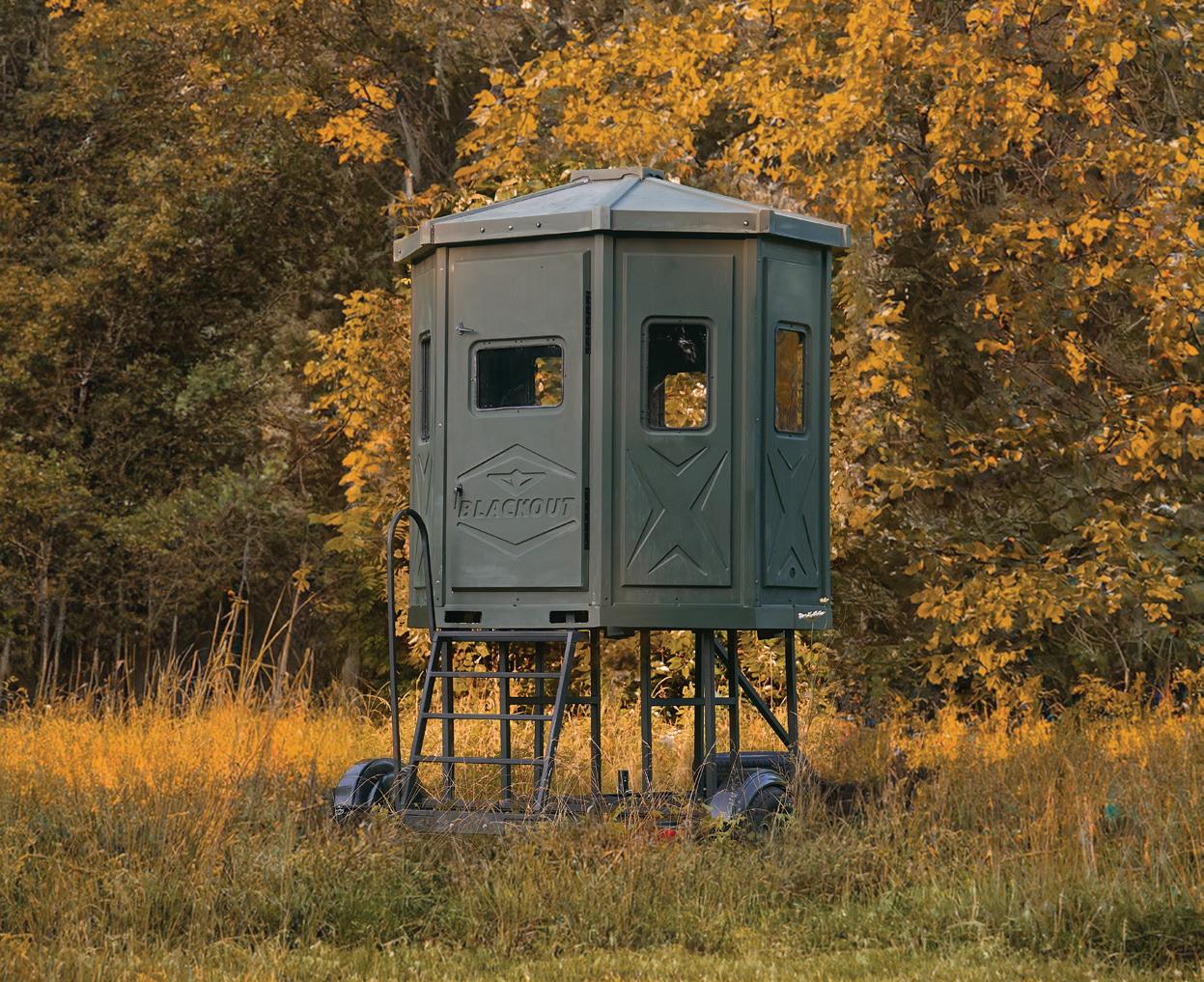

SHOP NOW
PROUD PARTNERS basspro.com
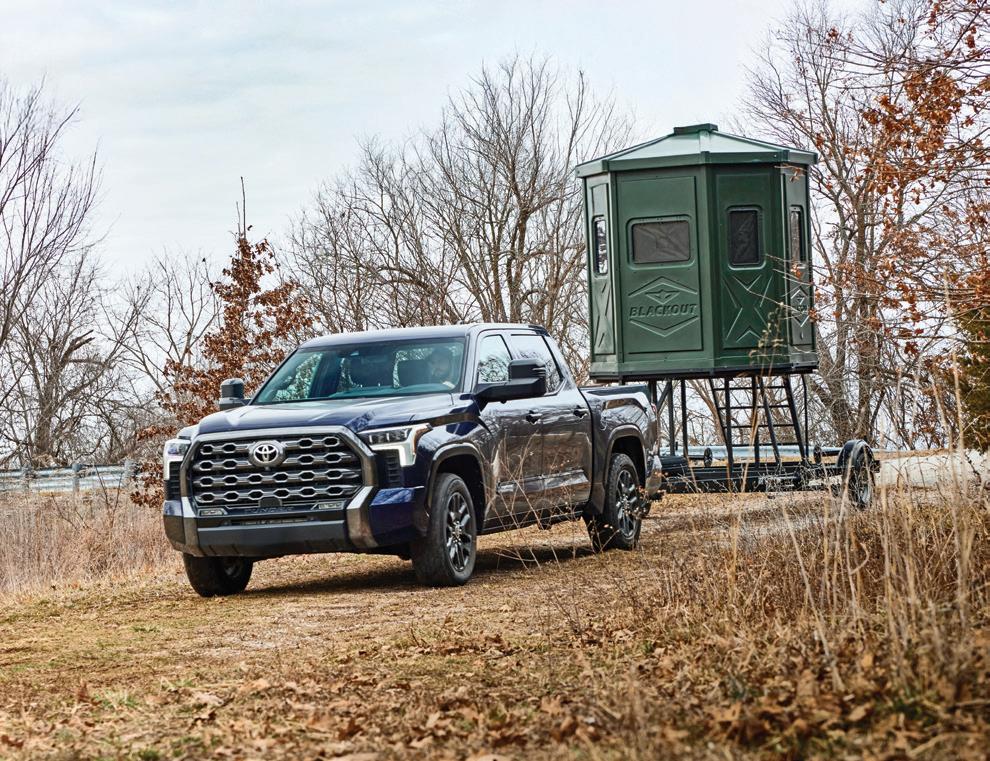
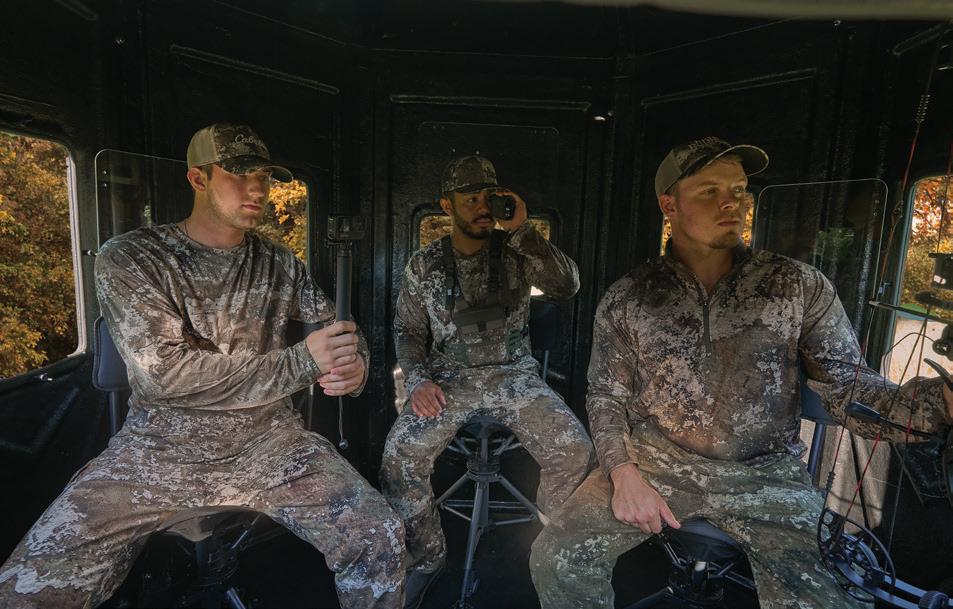
PERFECT FOR BOW OR GUN HUNTERS
DEAD-SILENT RUBBER FLOORING
LARGEST INTERIOR IN THE INDUSTRY!
COMFORTABLY FITS UP TO 3 ADULTS
Bass Pro Shops® and Cabela’s® are proud to stand alongside our customers in support of the Conservation Federation of Missouri. Our partnership has made significant strides in protecting our rich outdoor heritage for future generations. Together, we are ensuring the conservation of Missouri’s abundant wildlife and natural resources. Learn more at basspro.com/conservation
